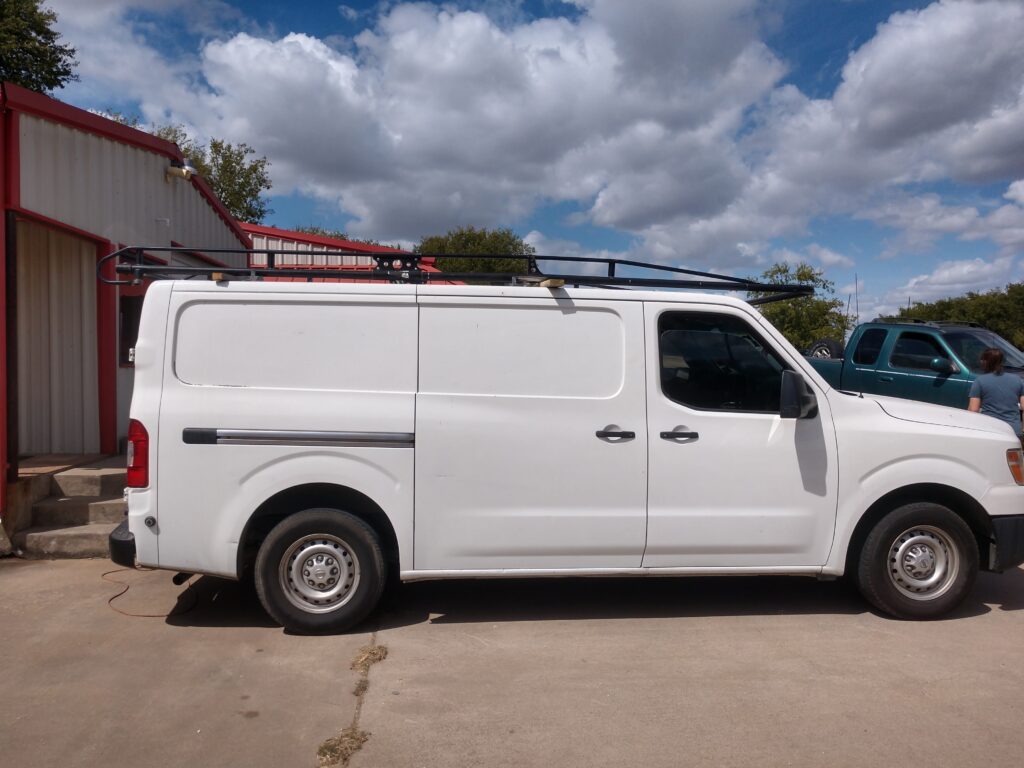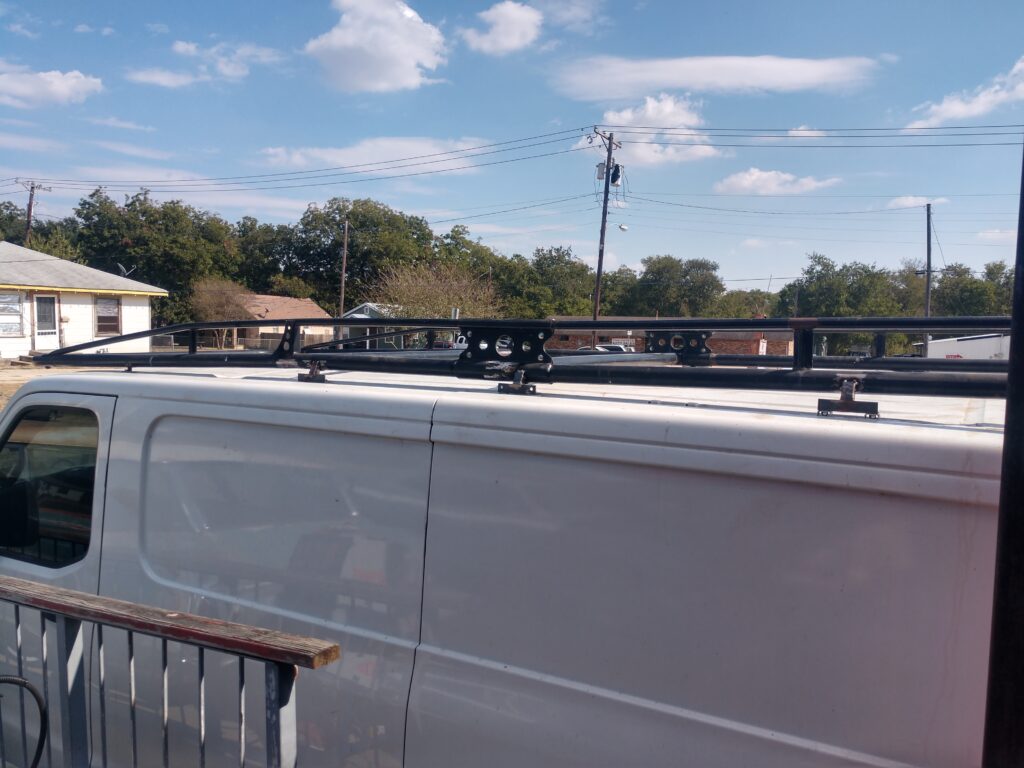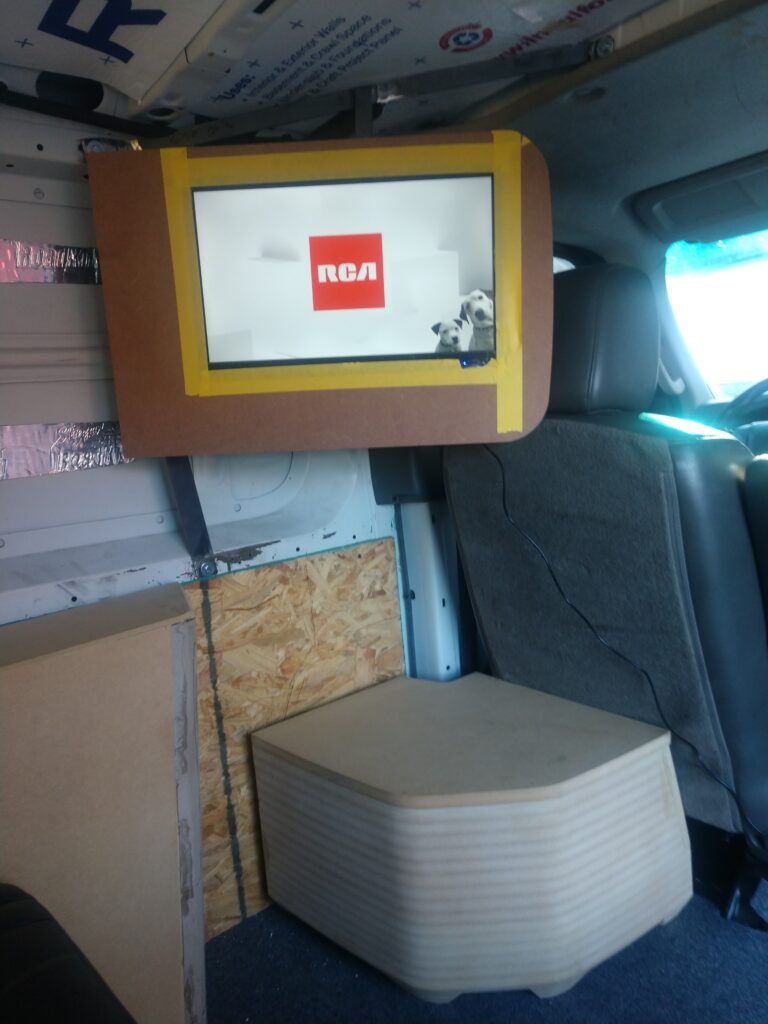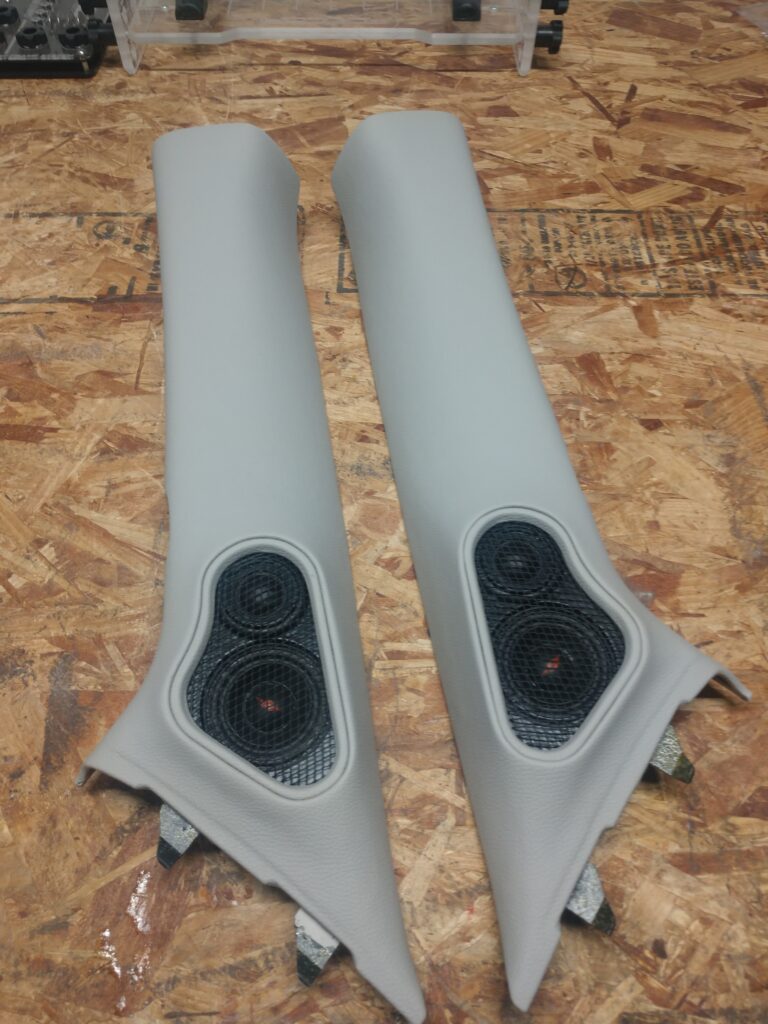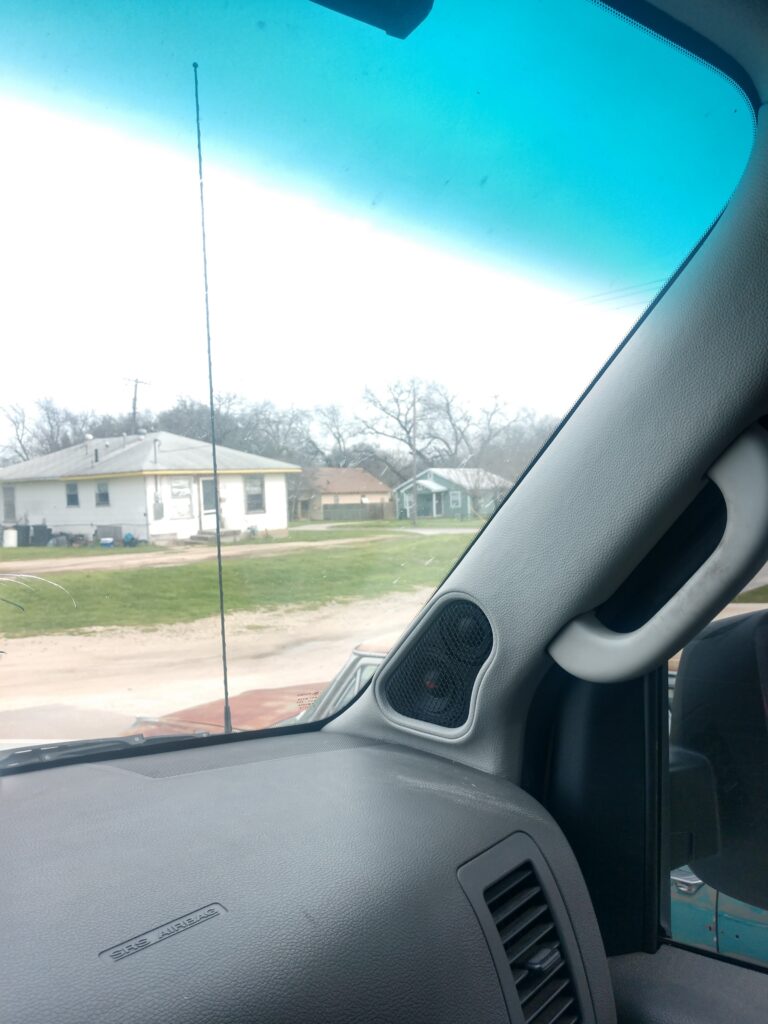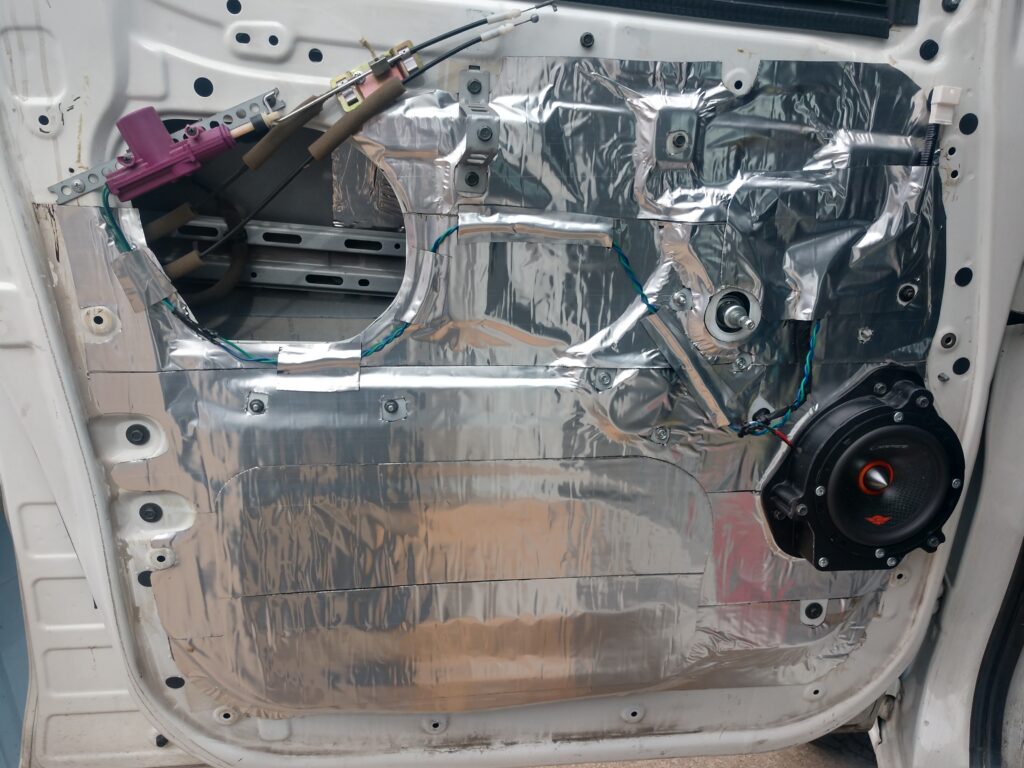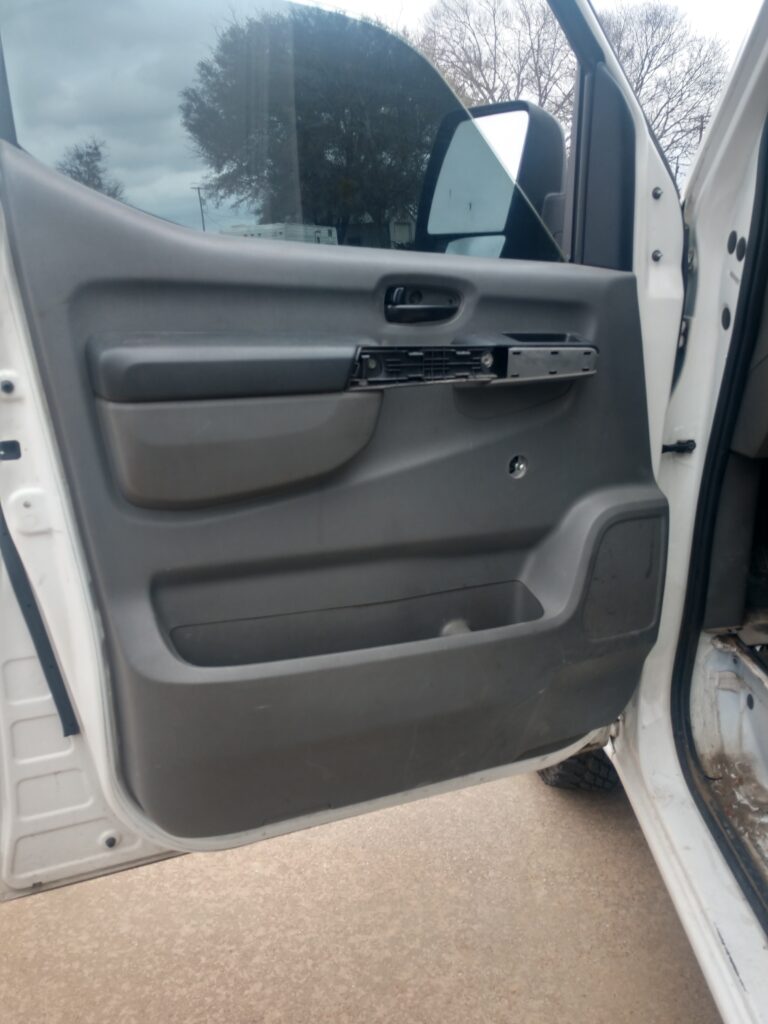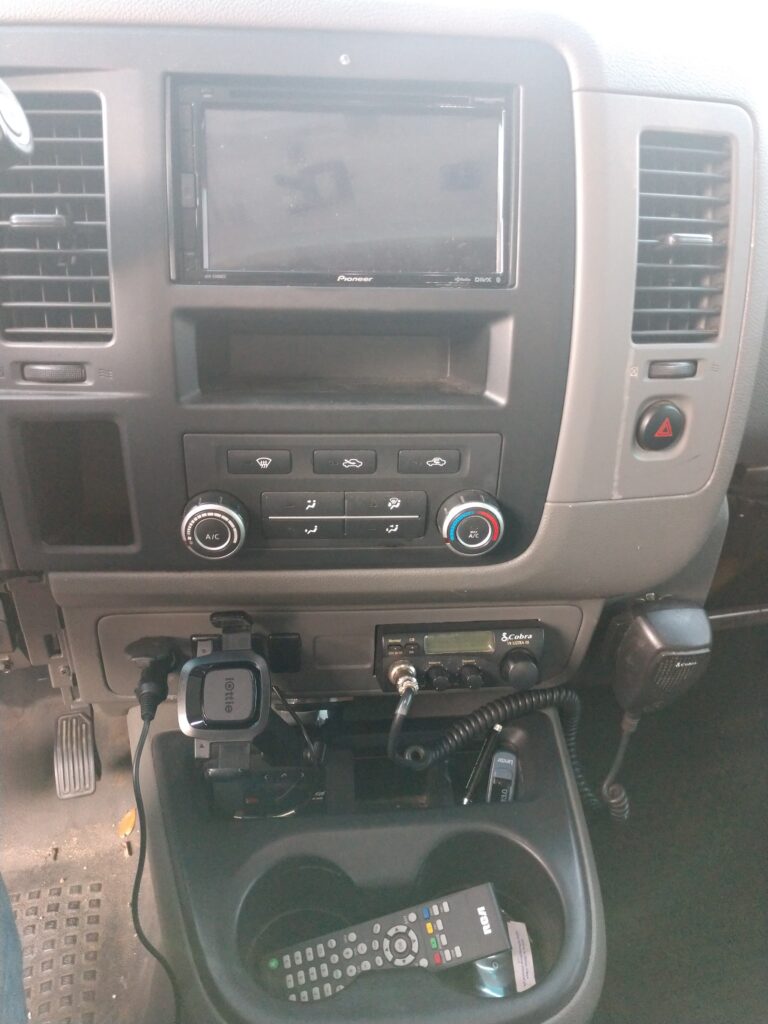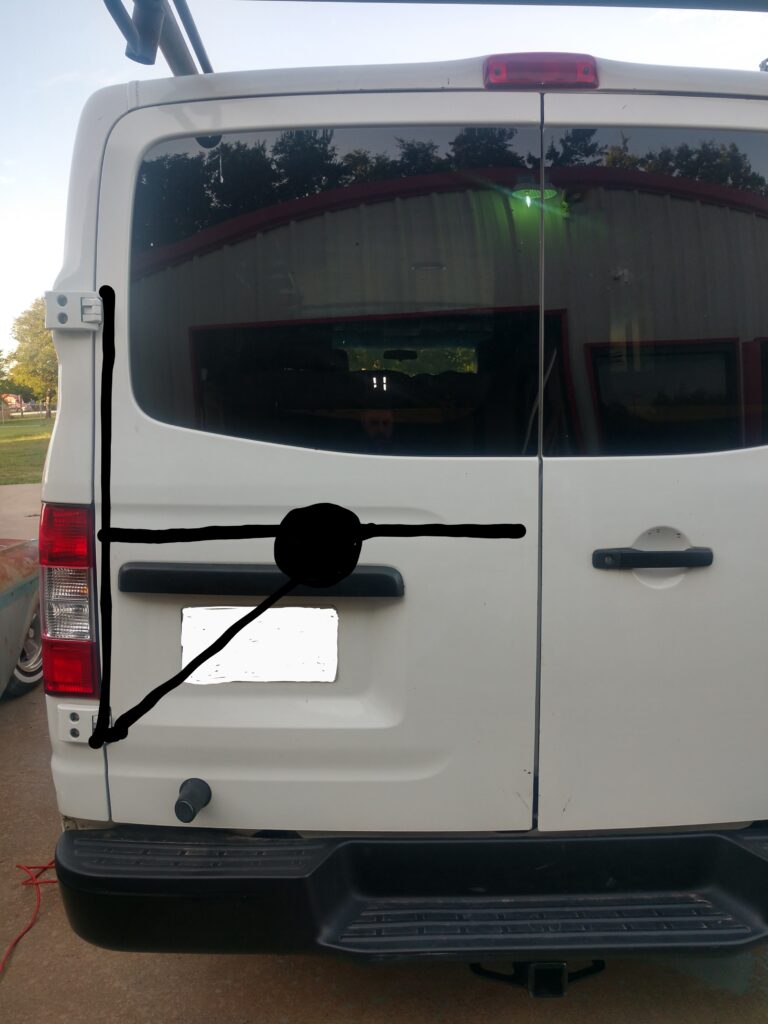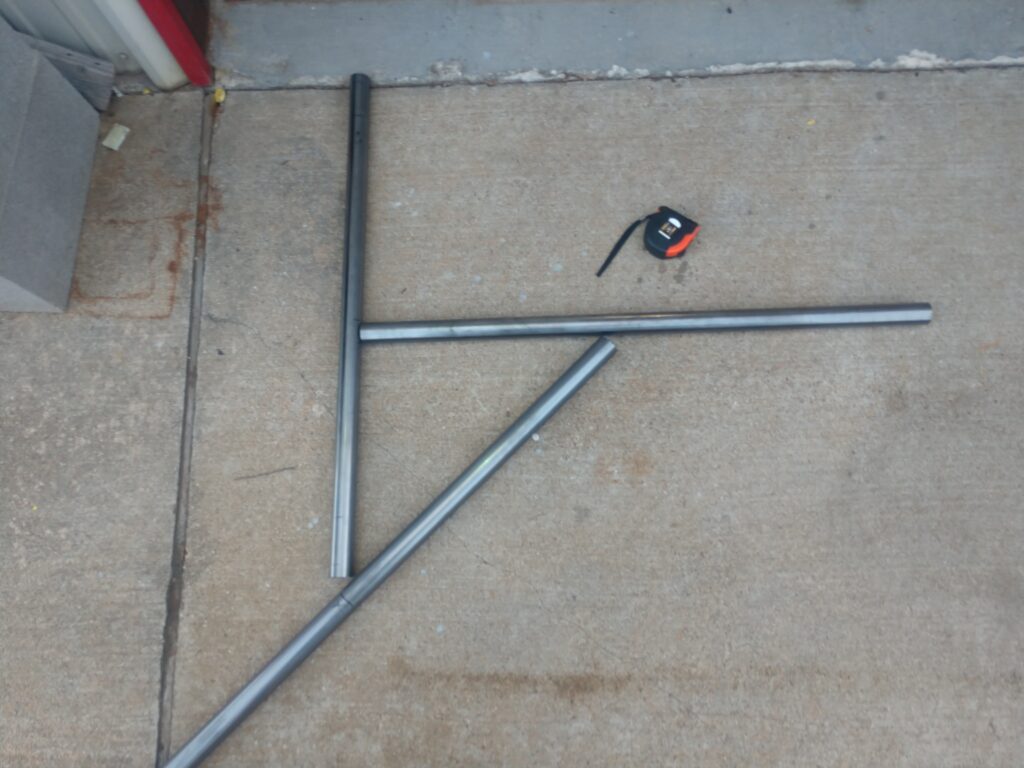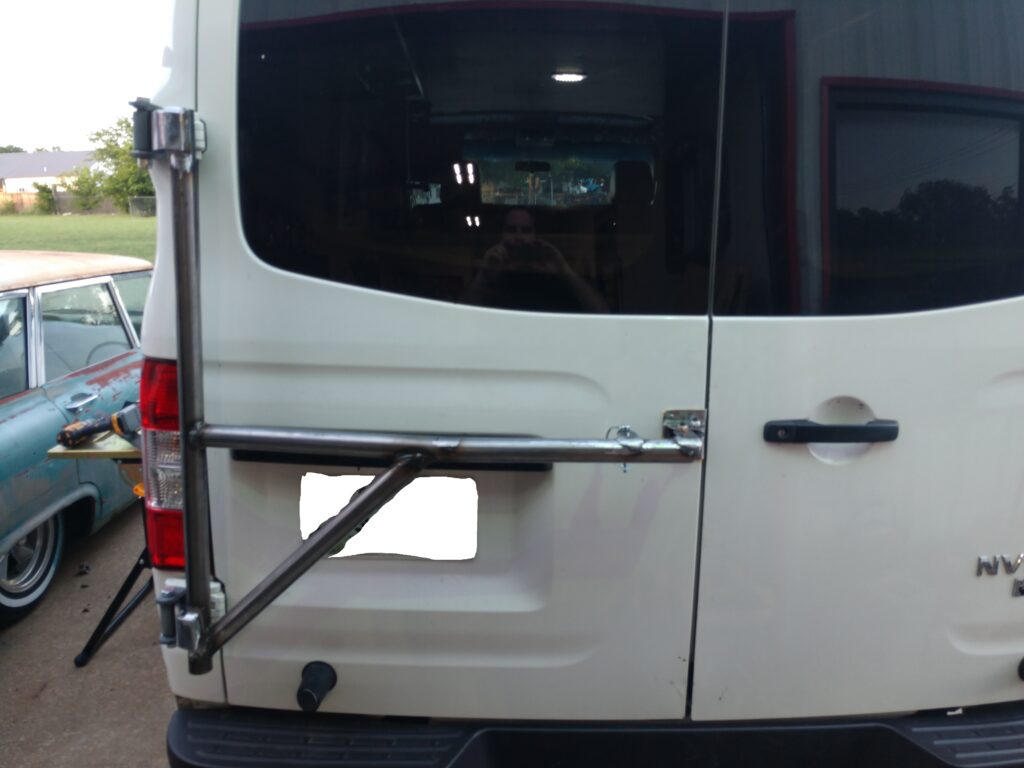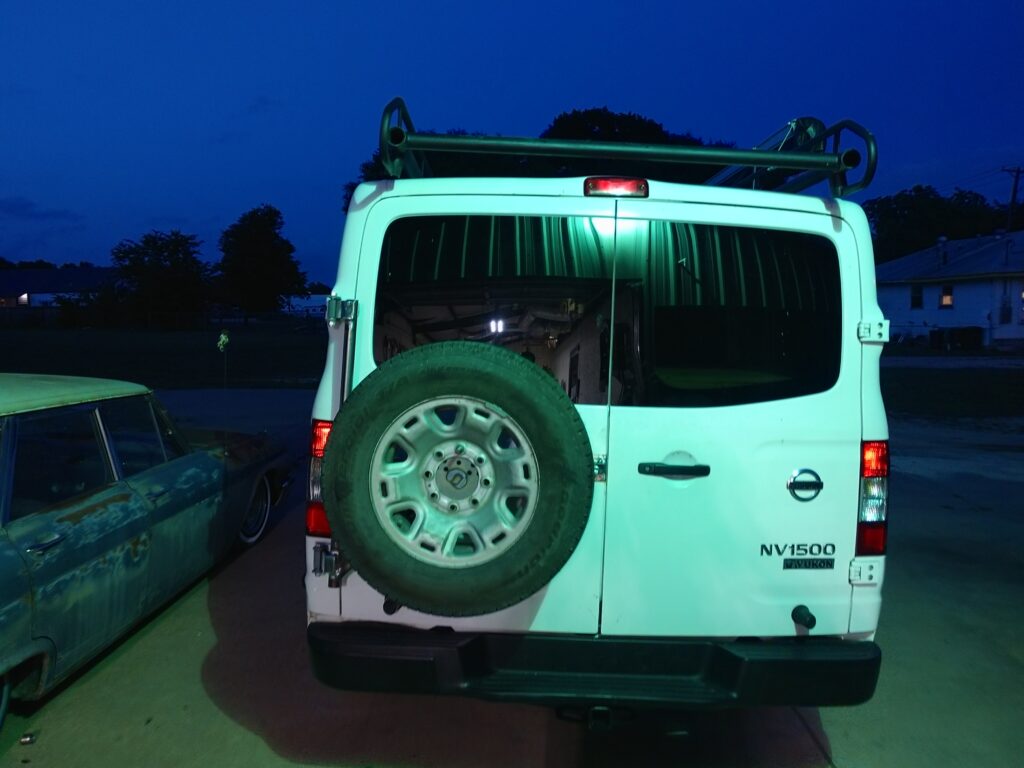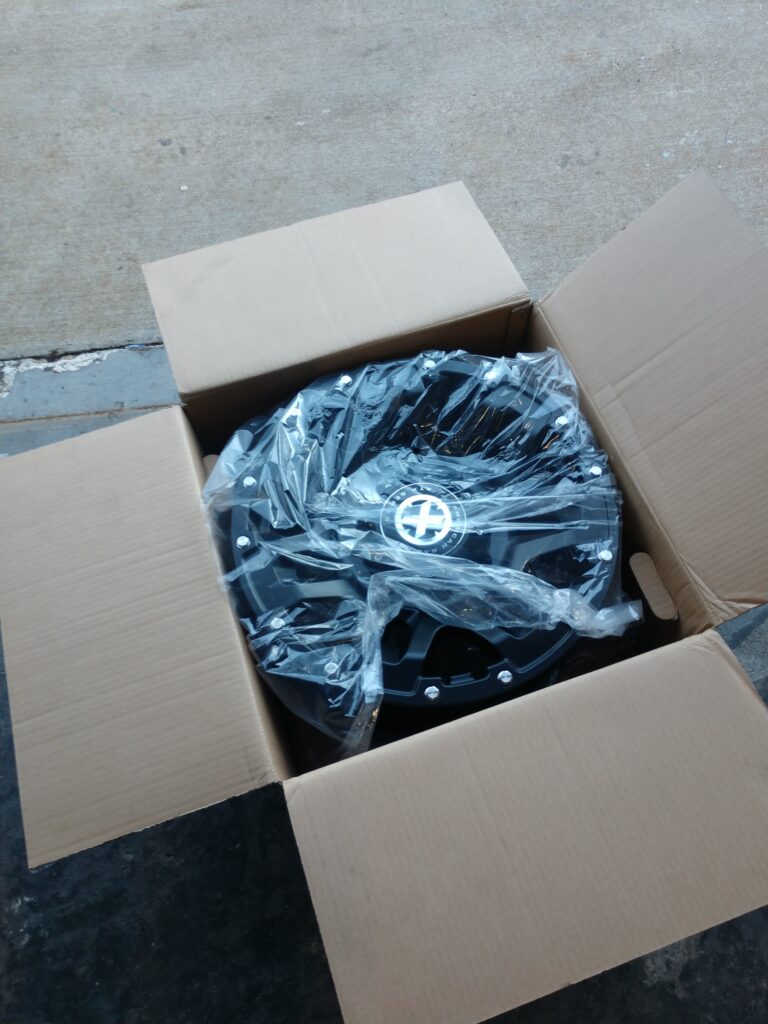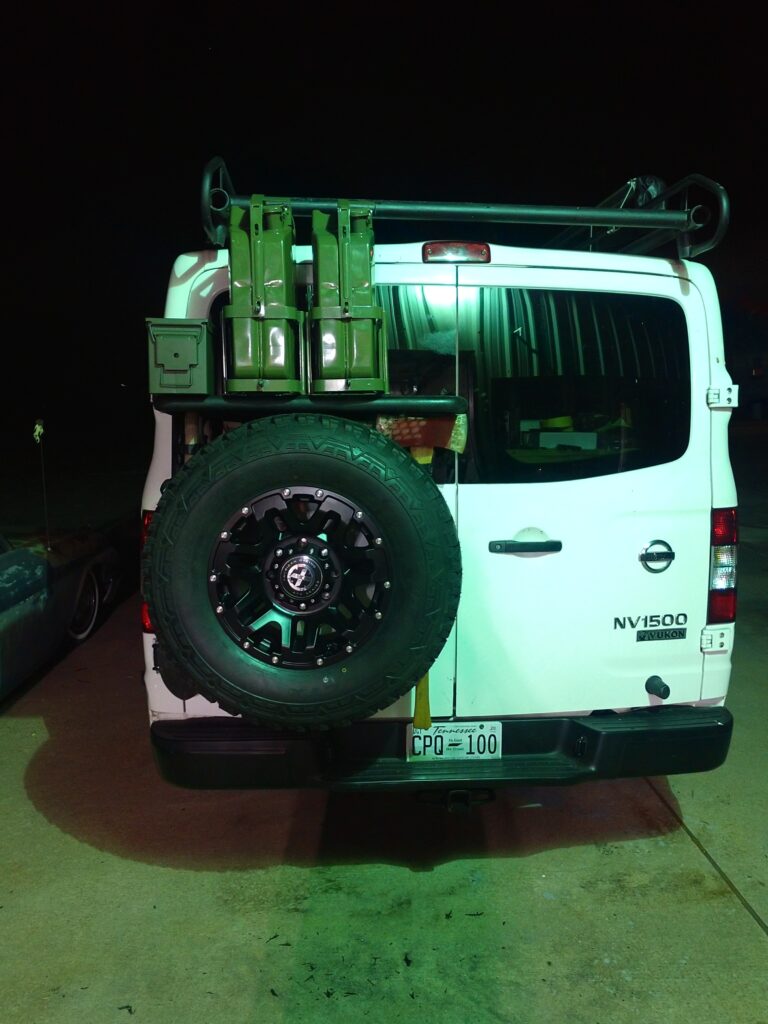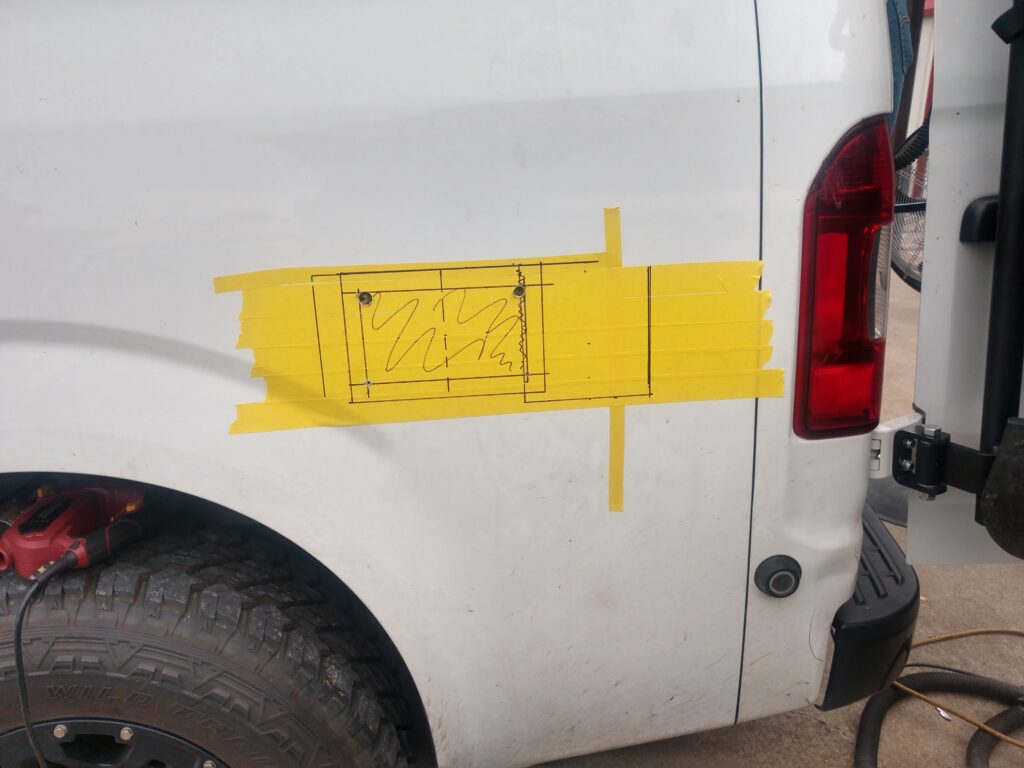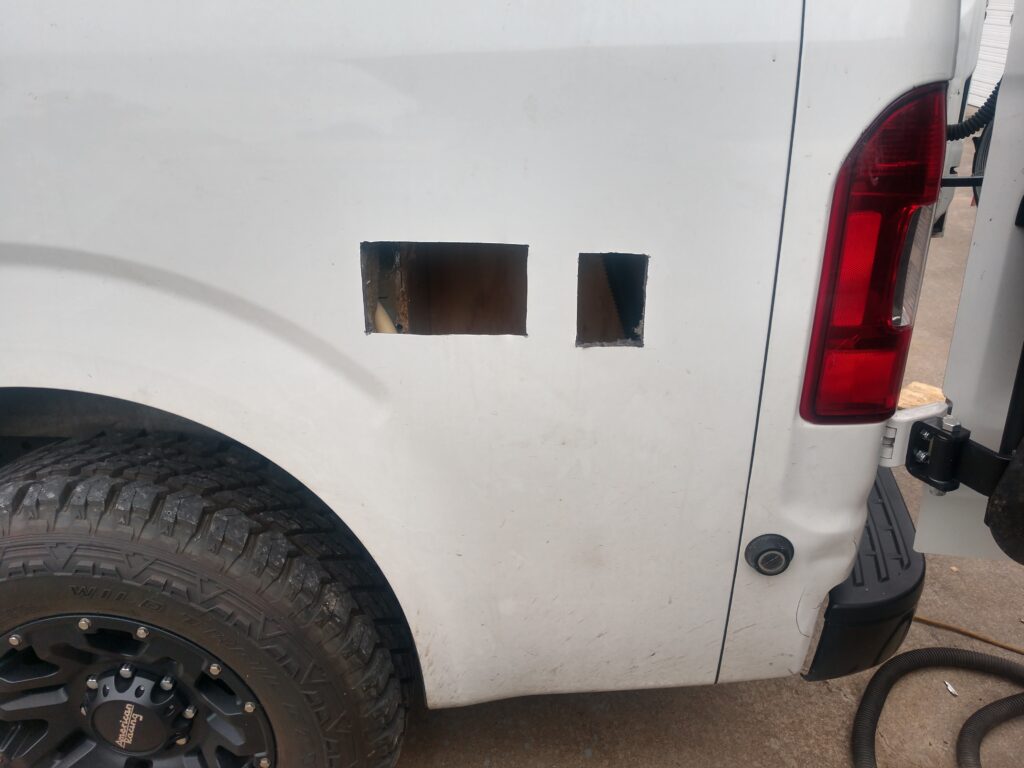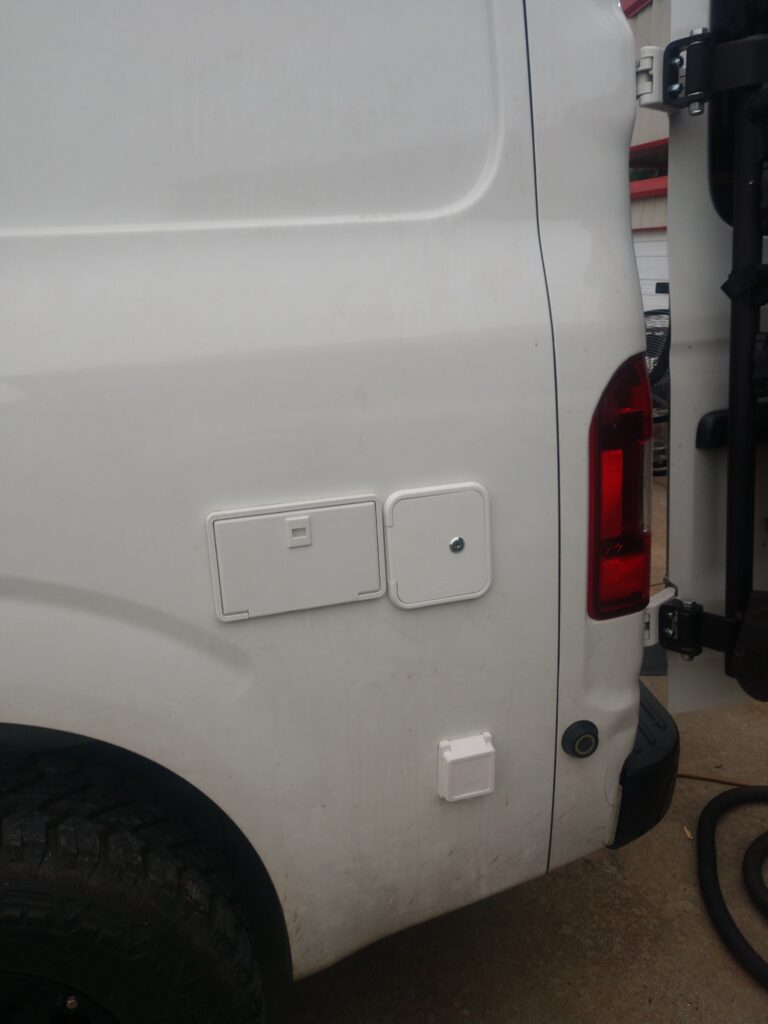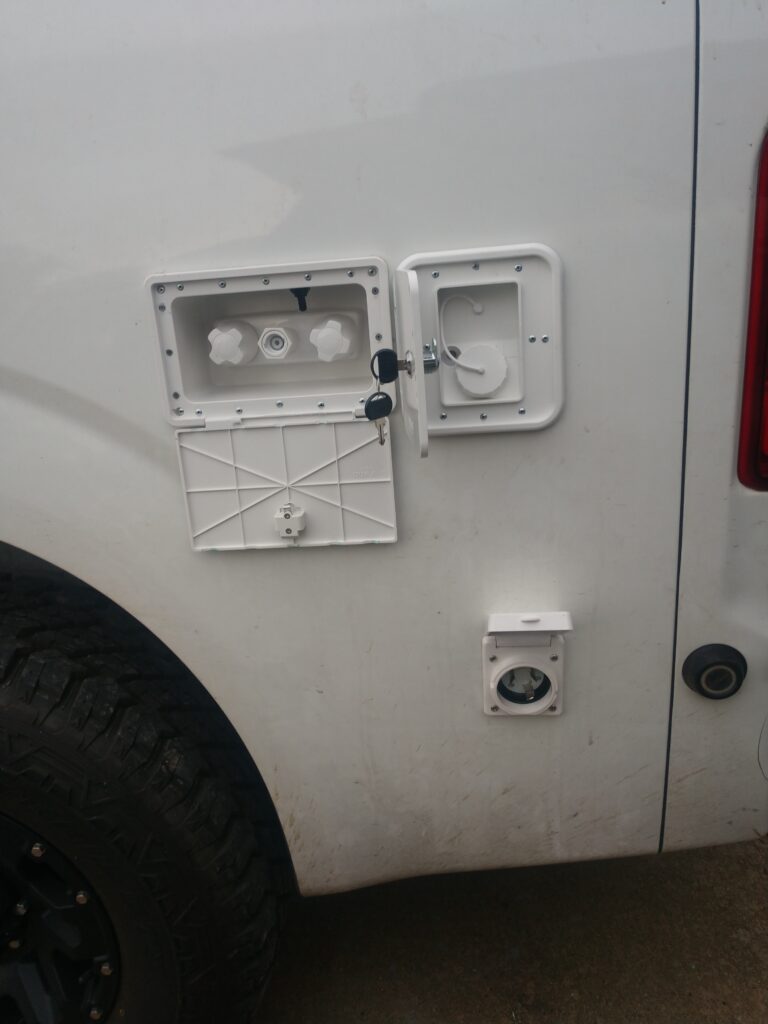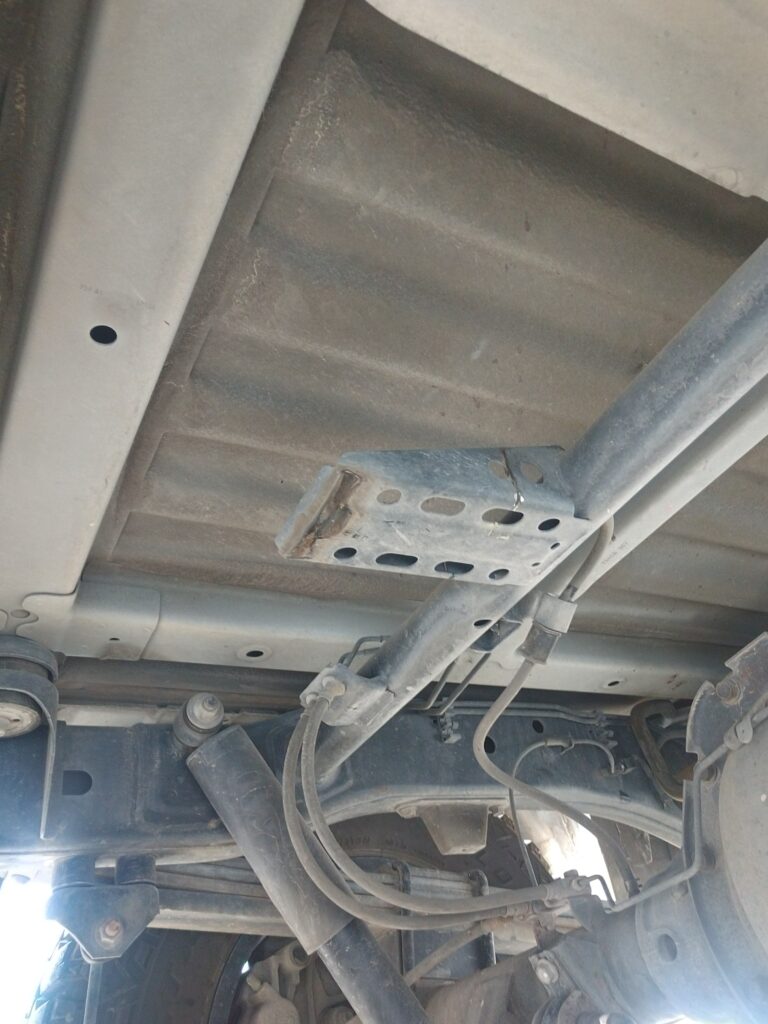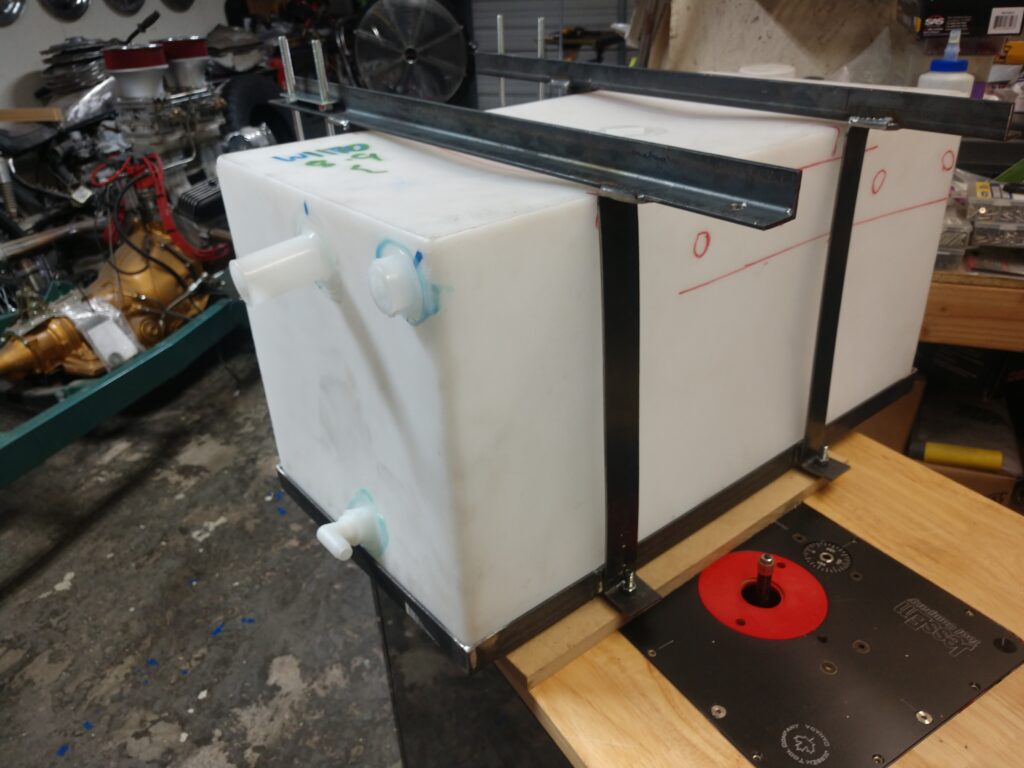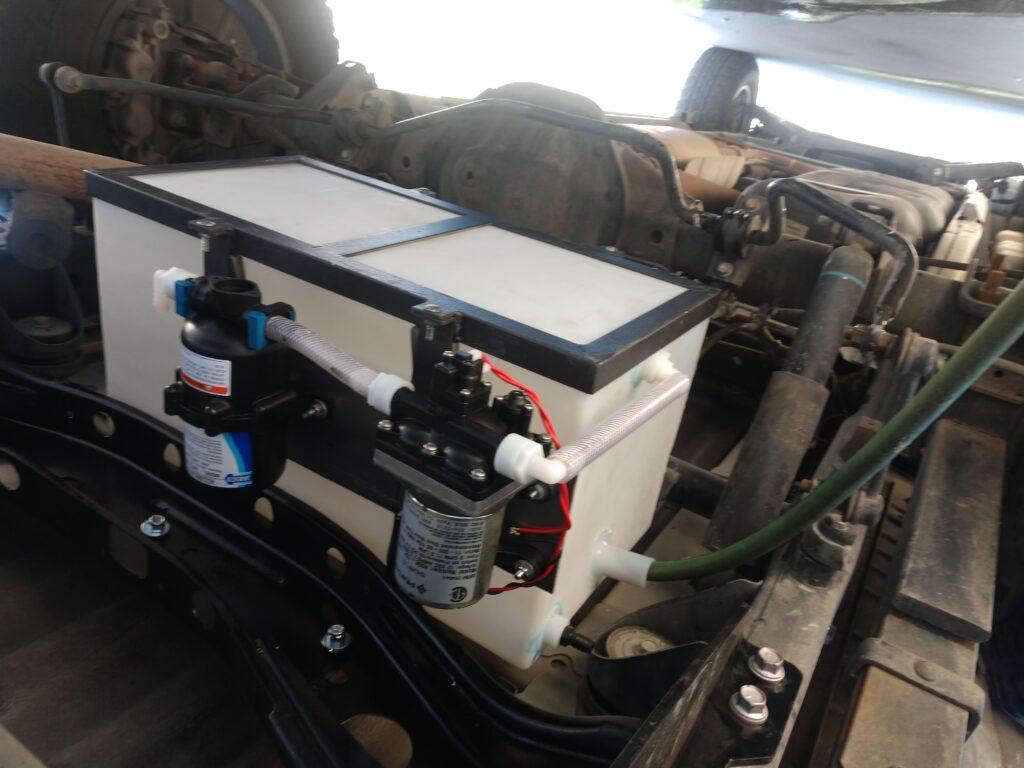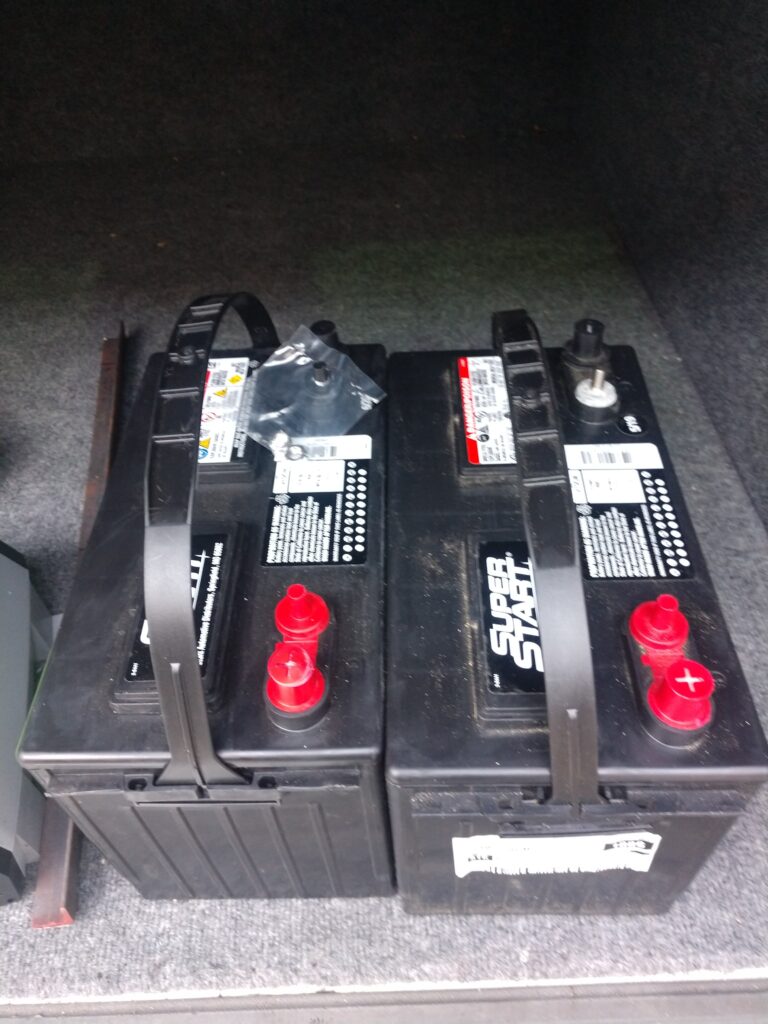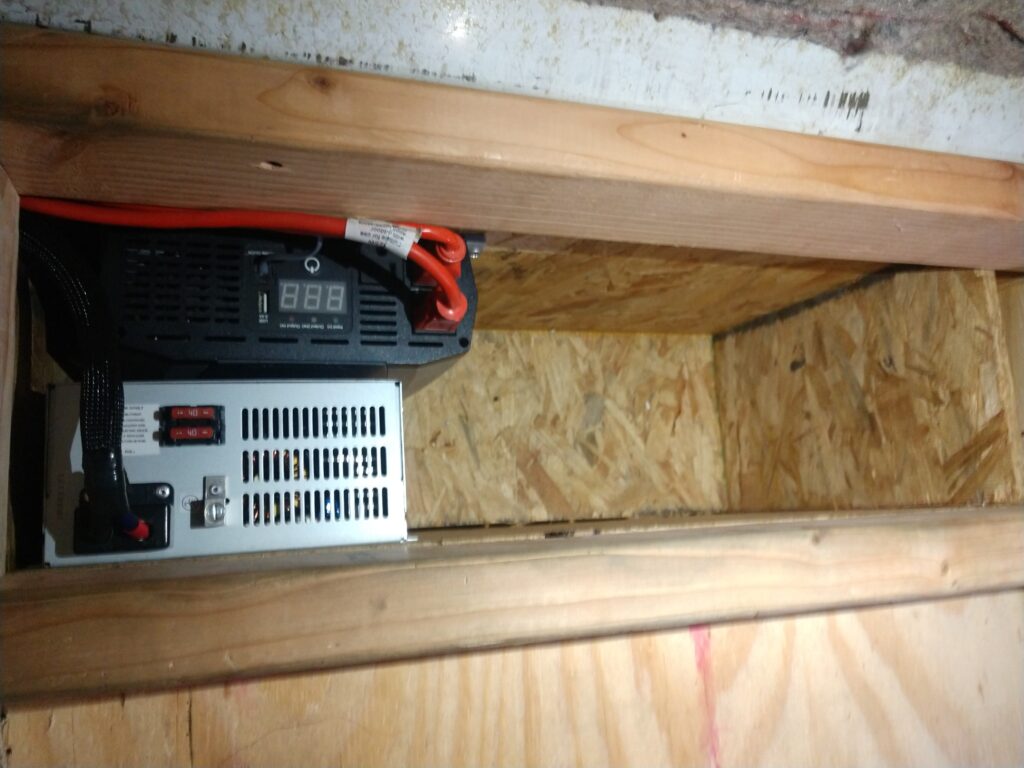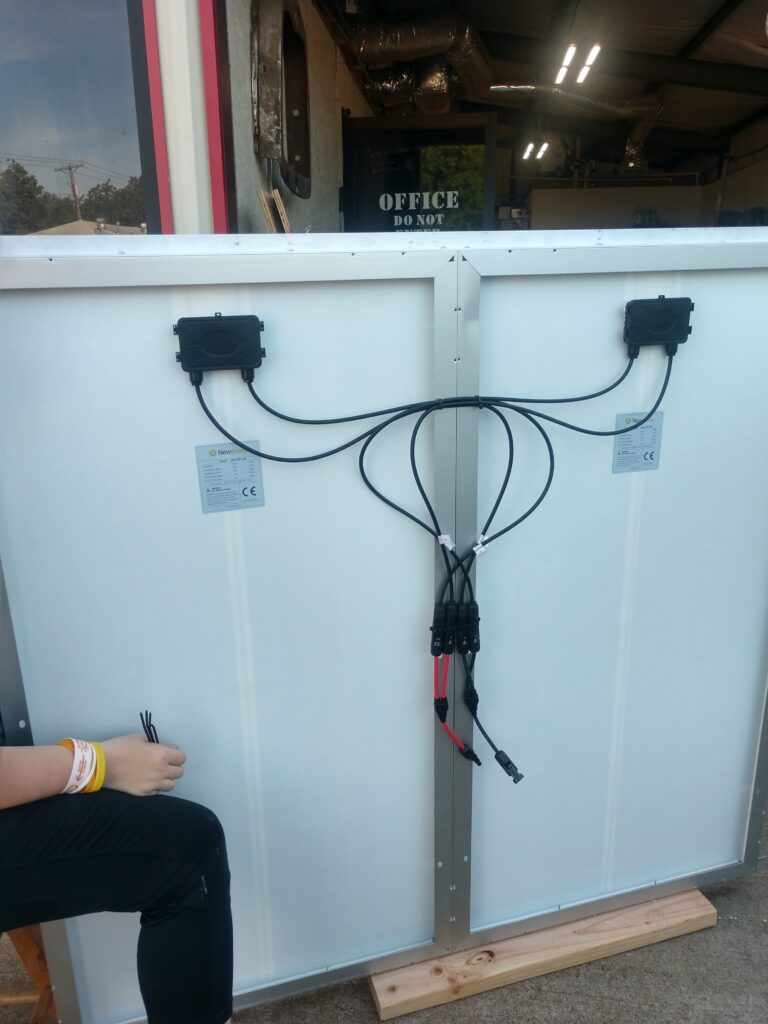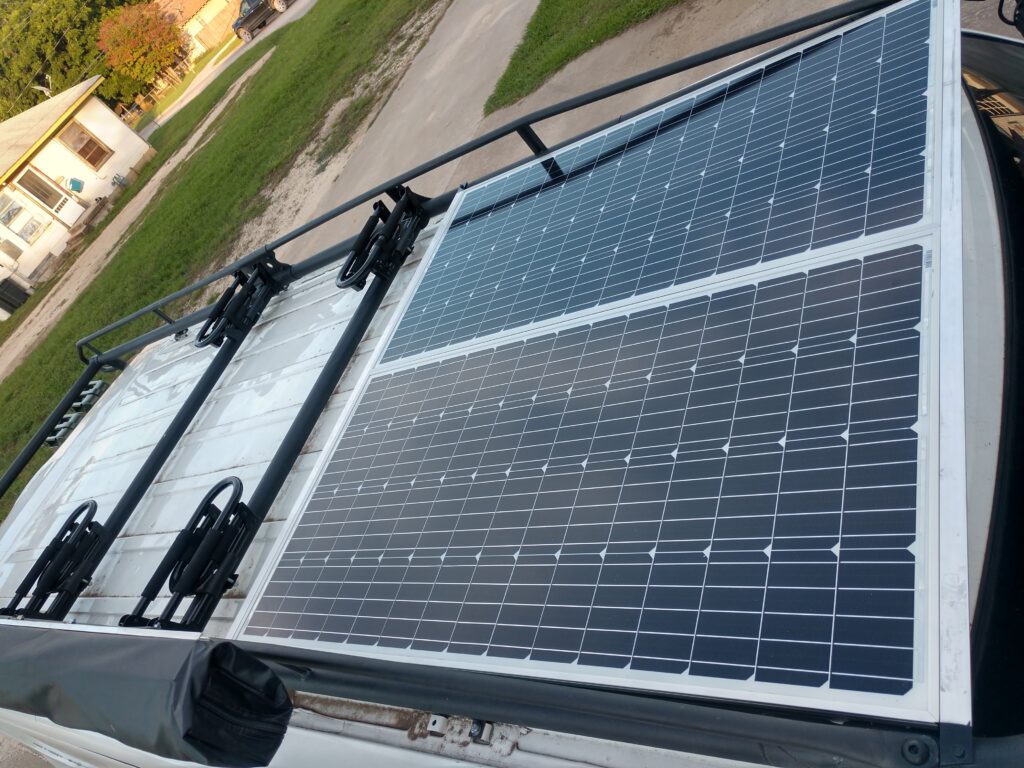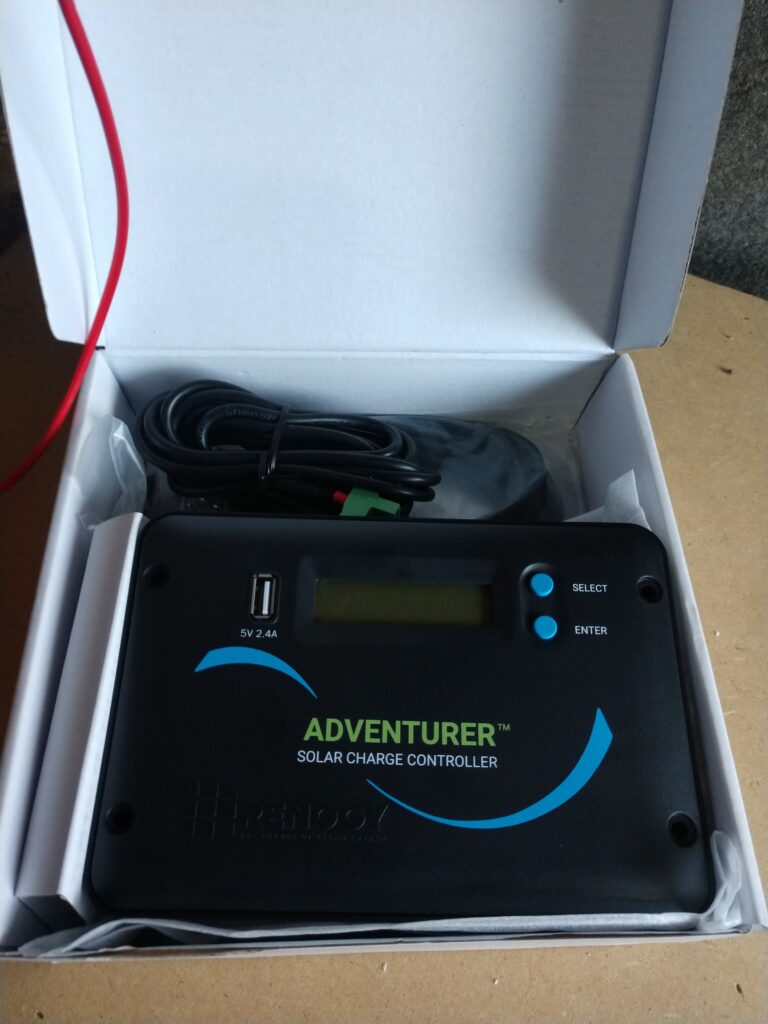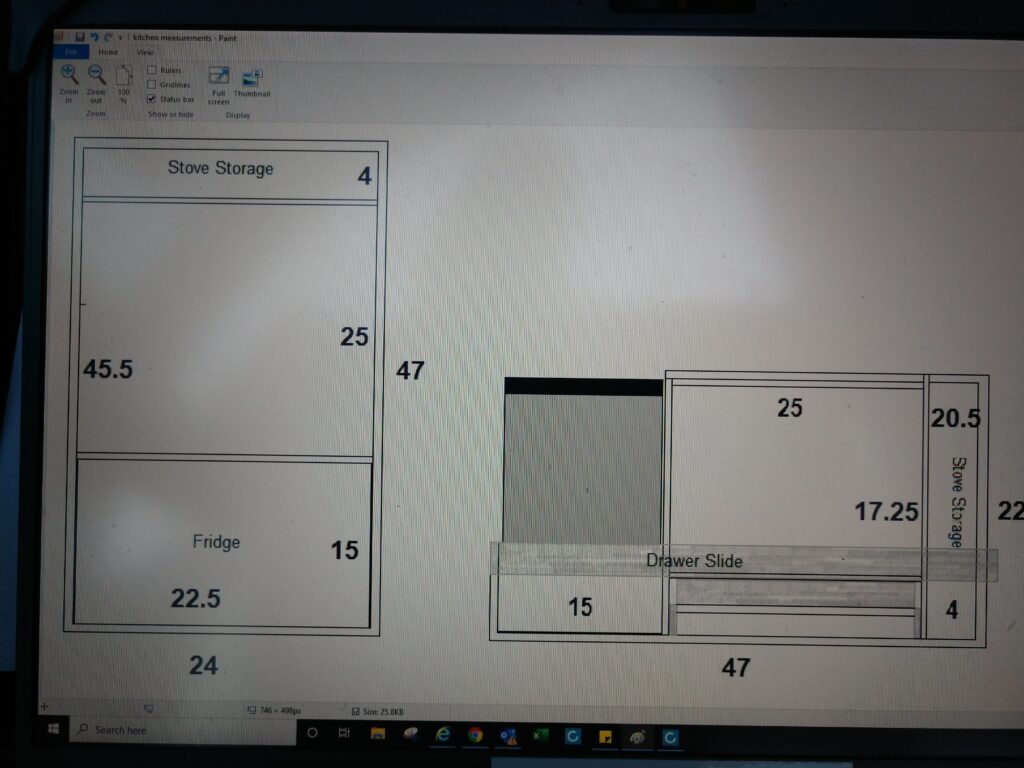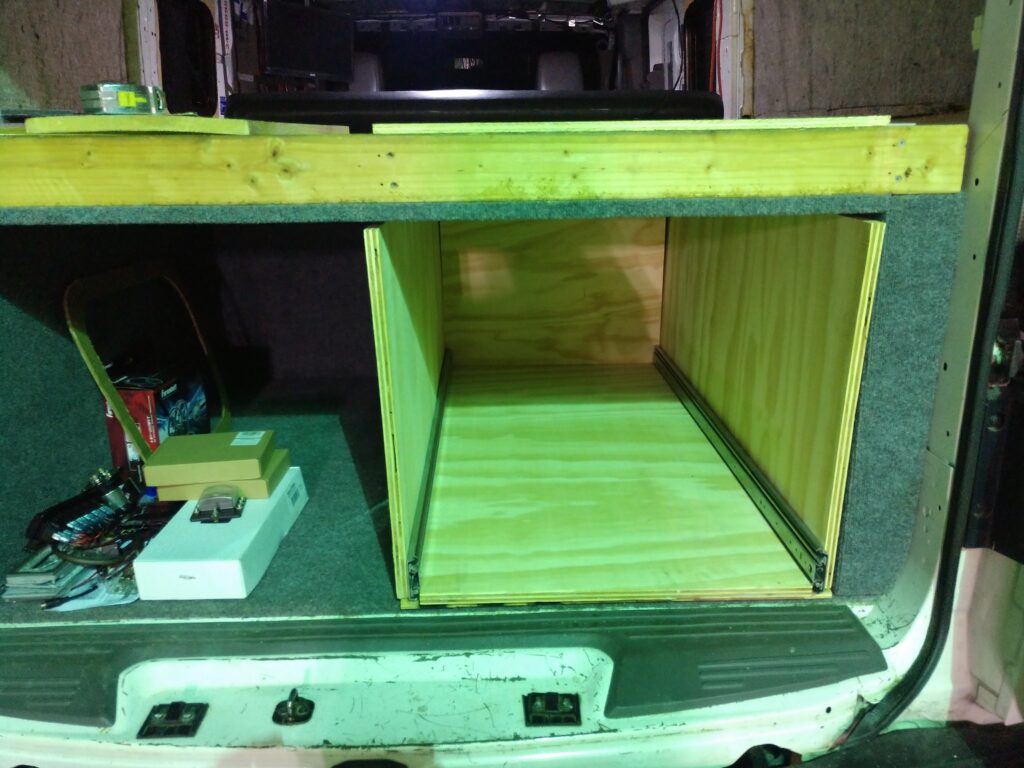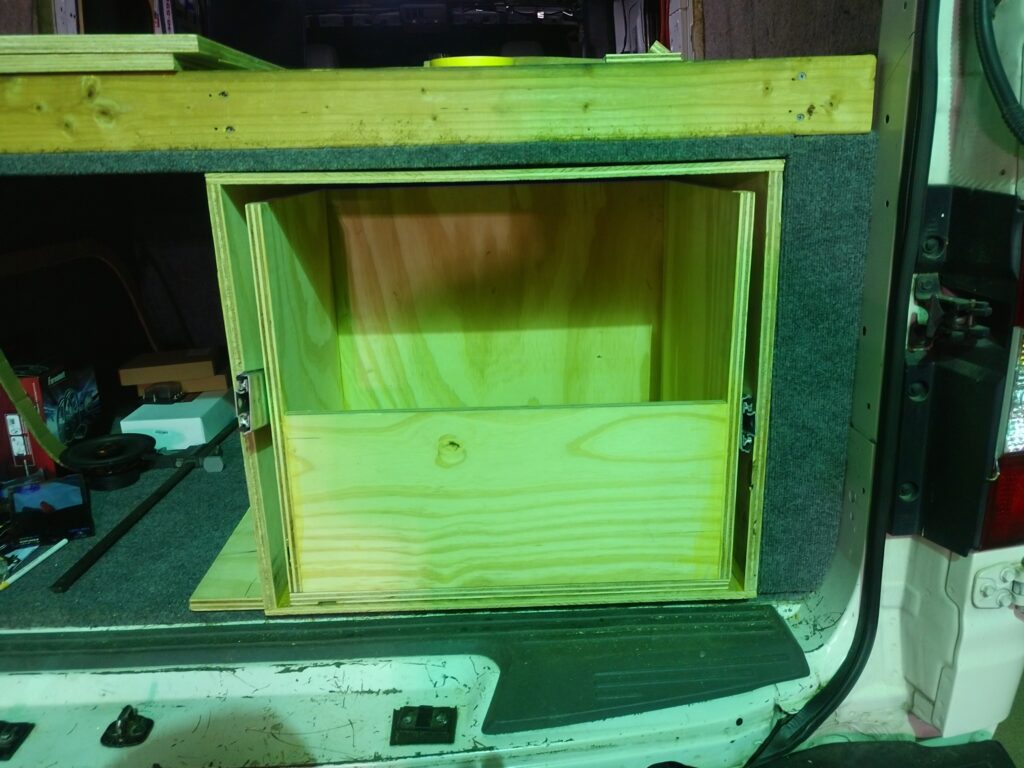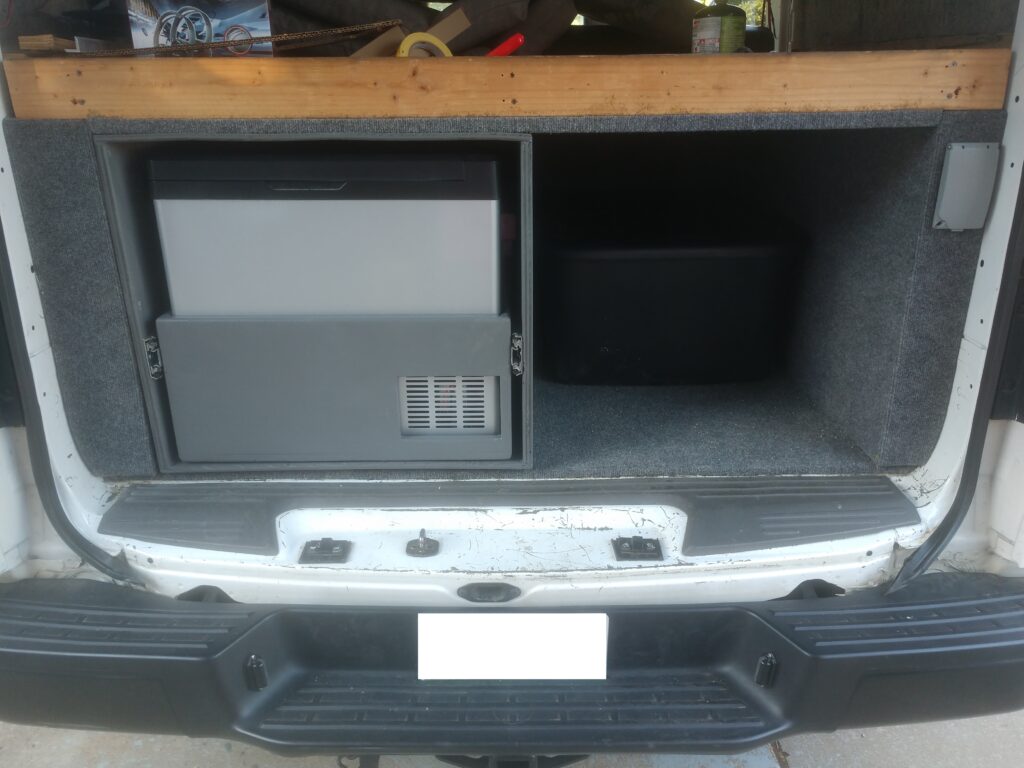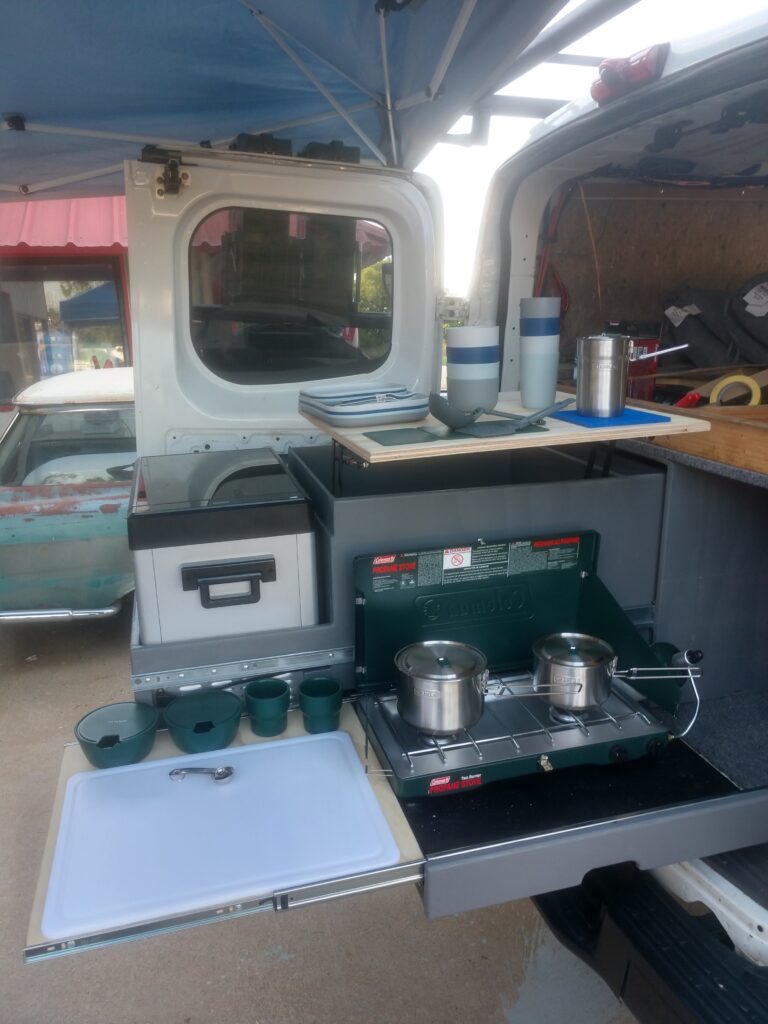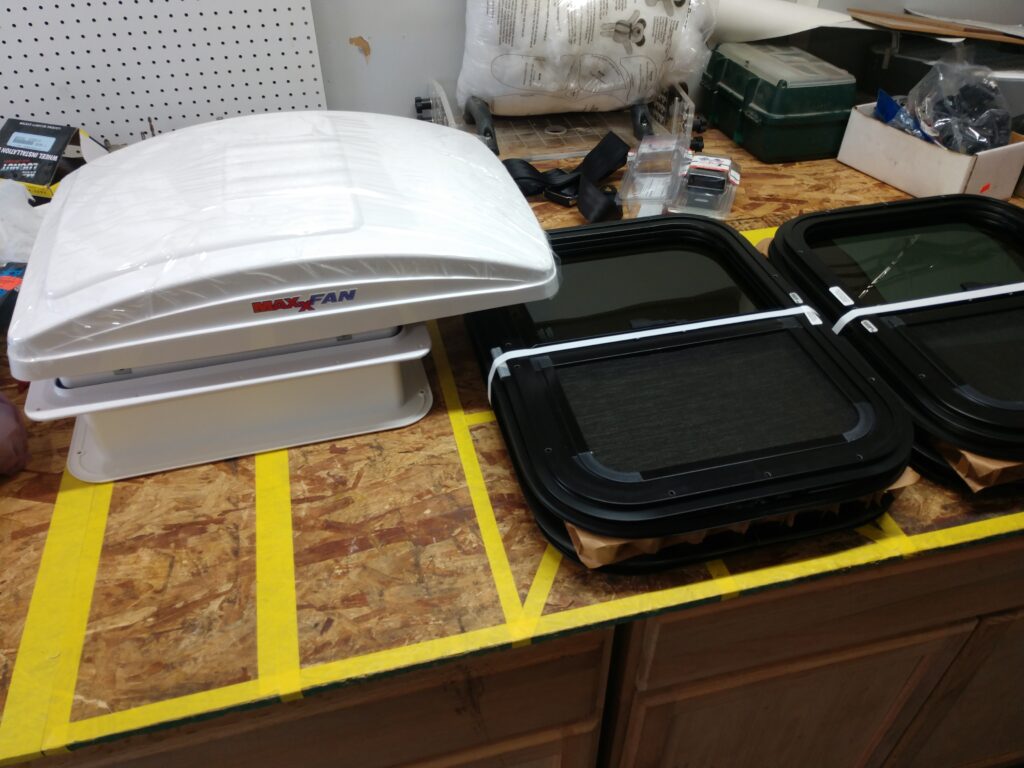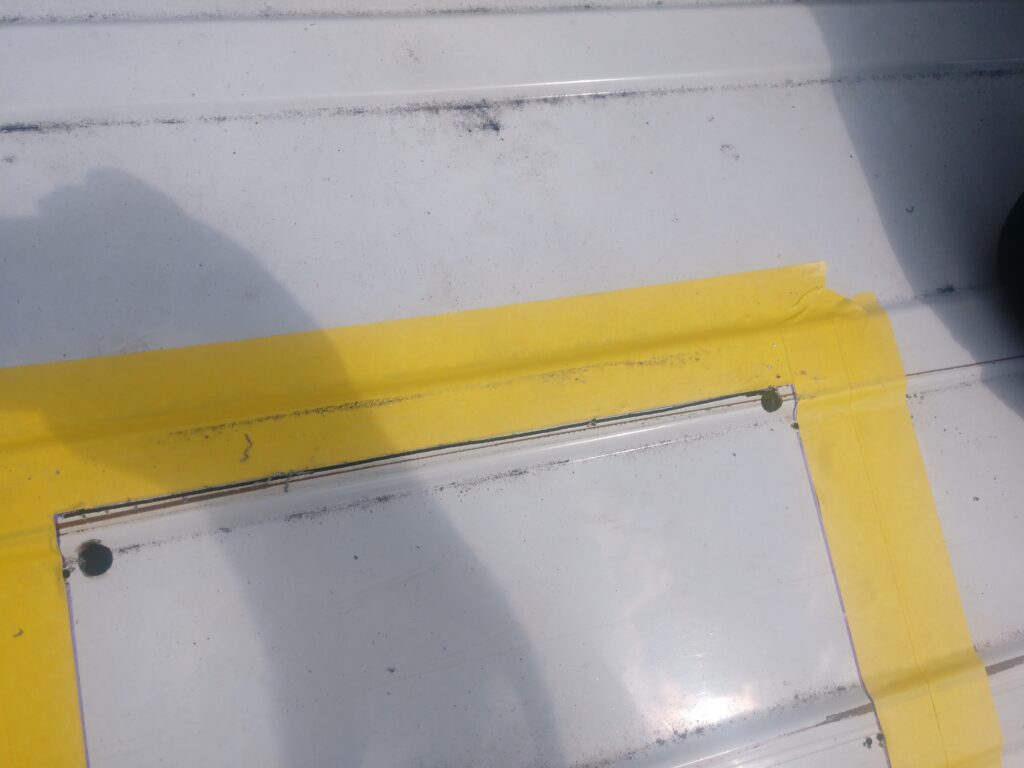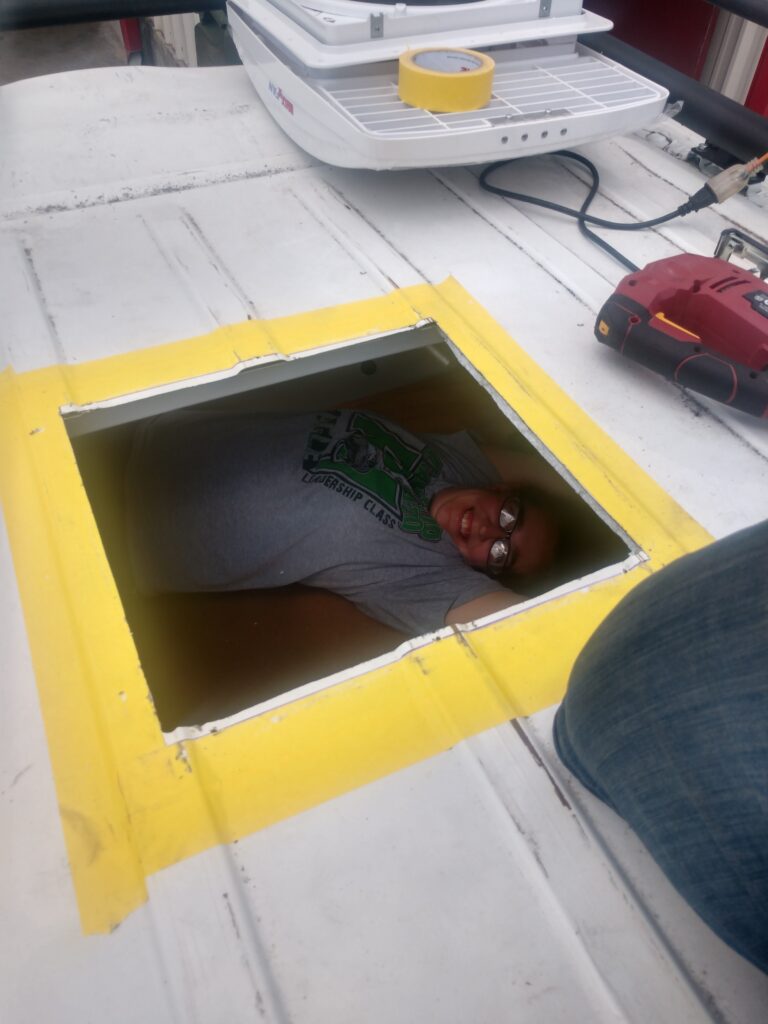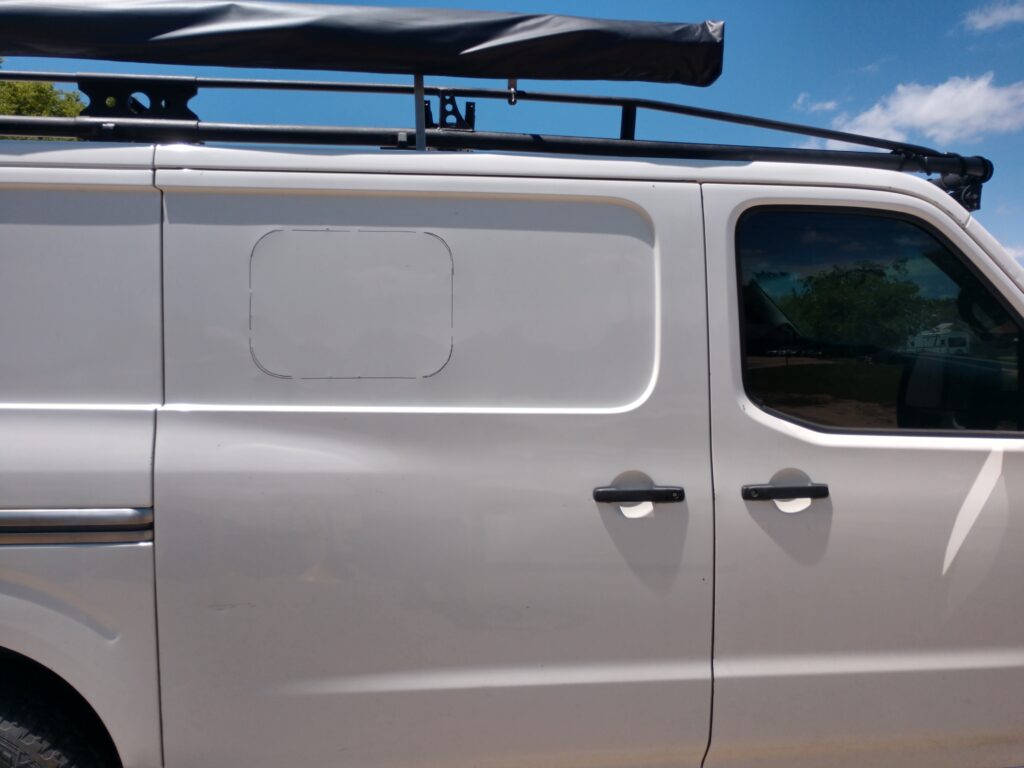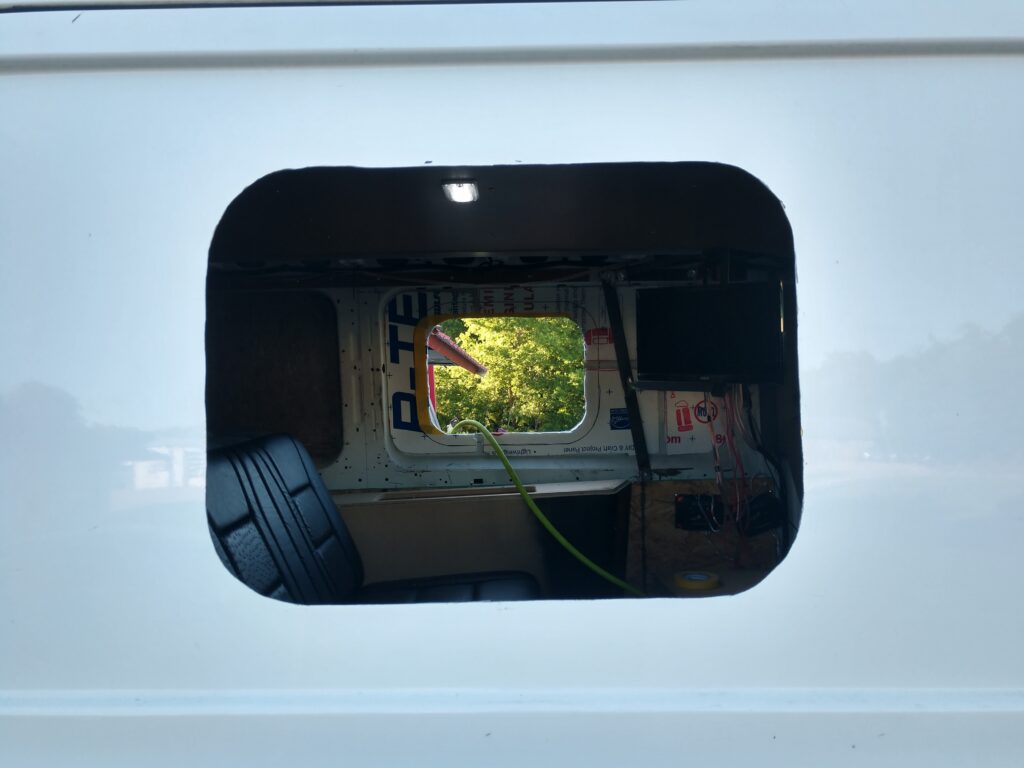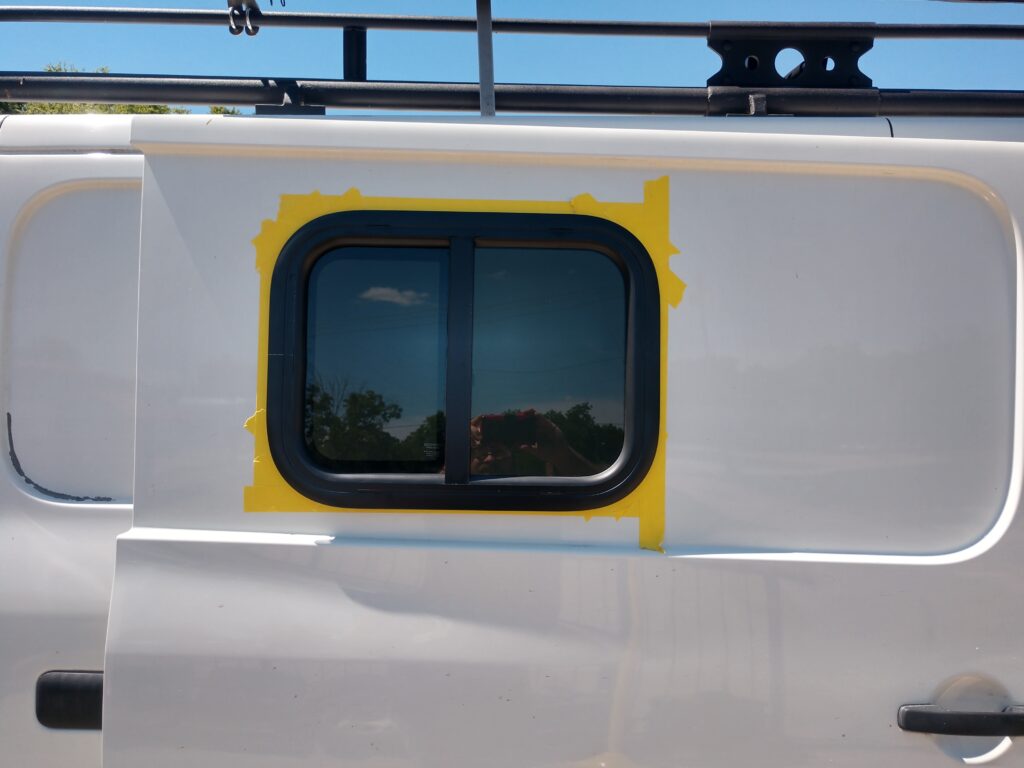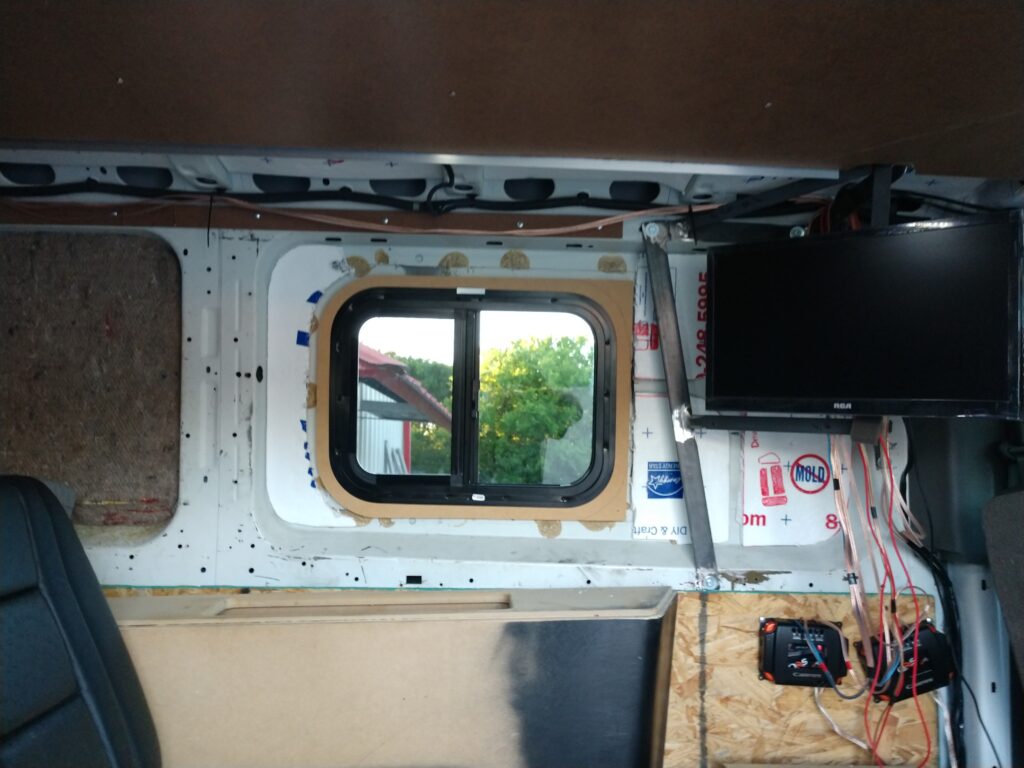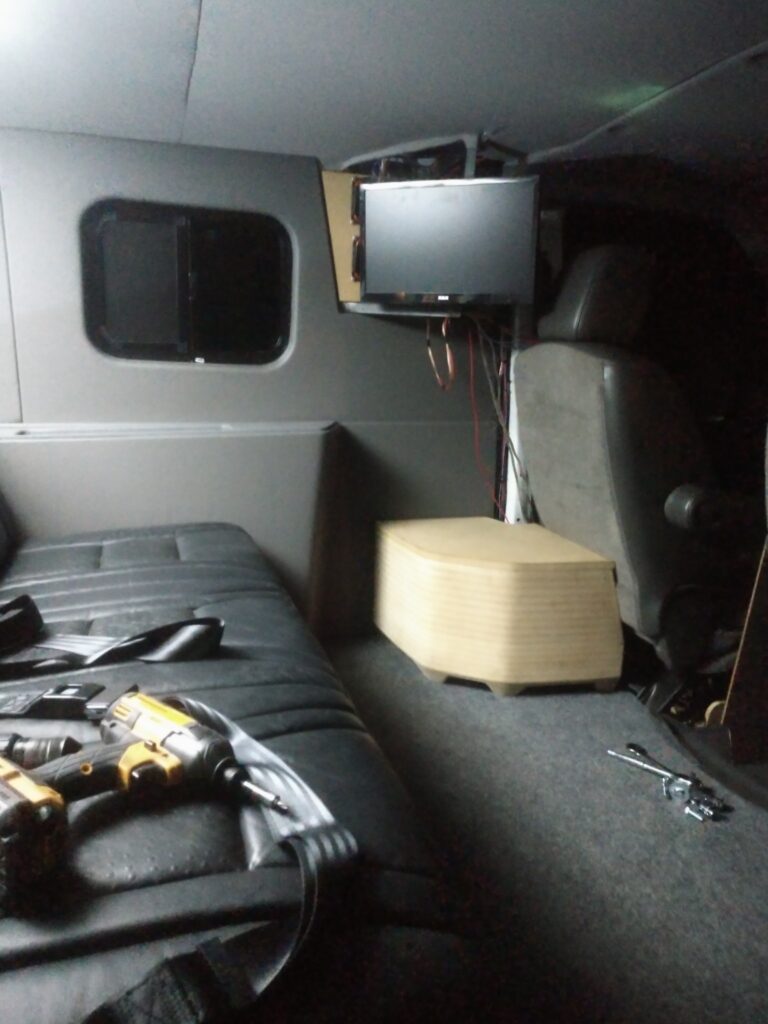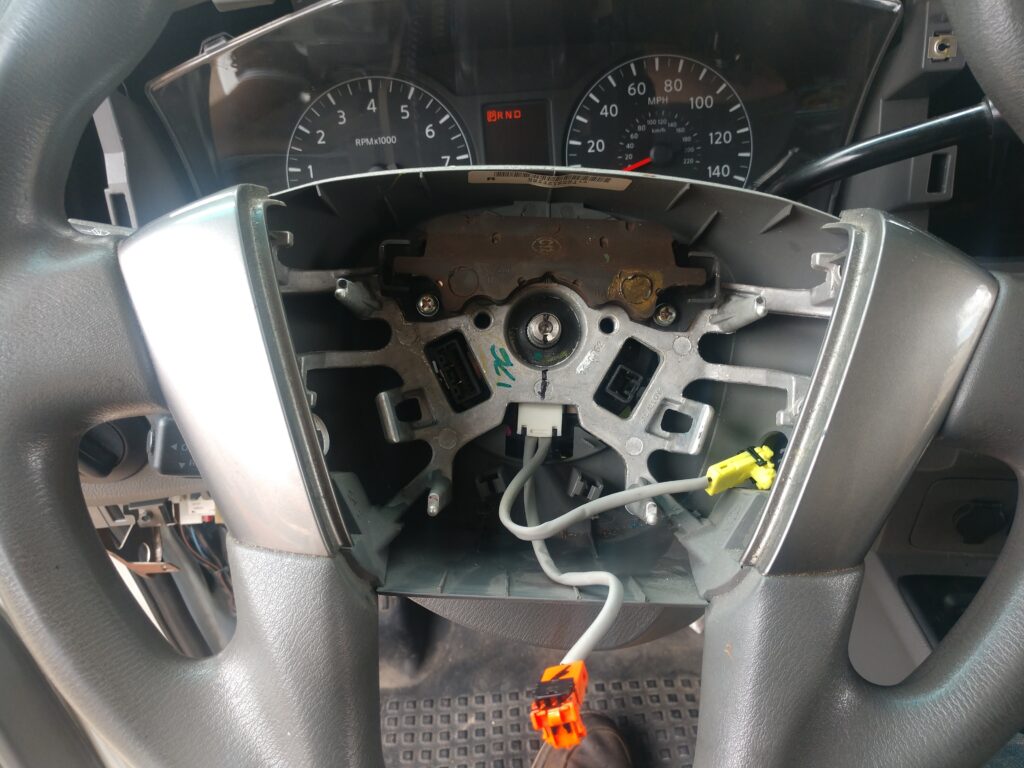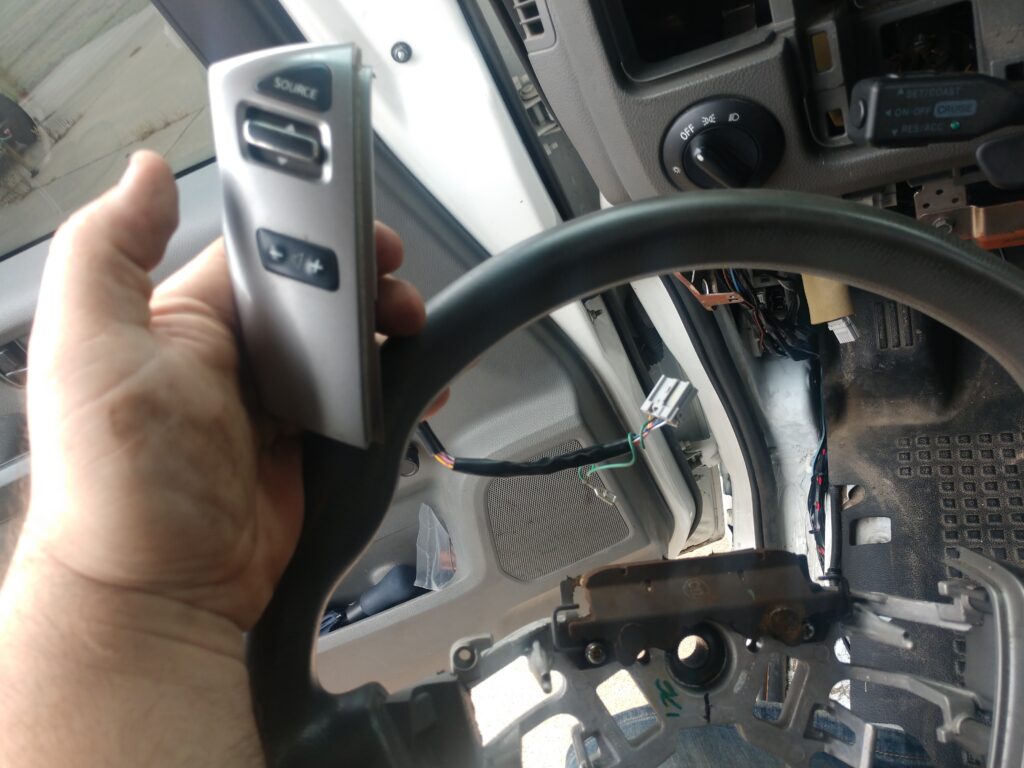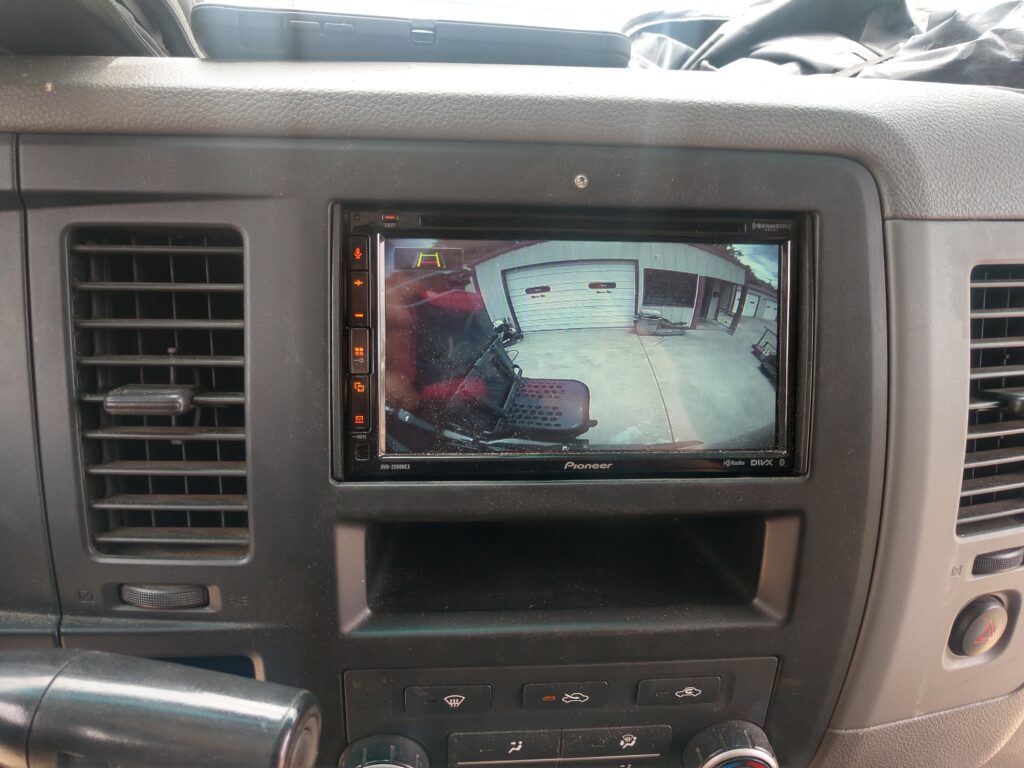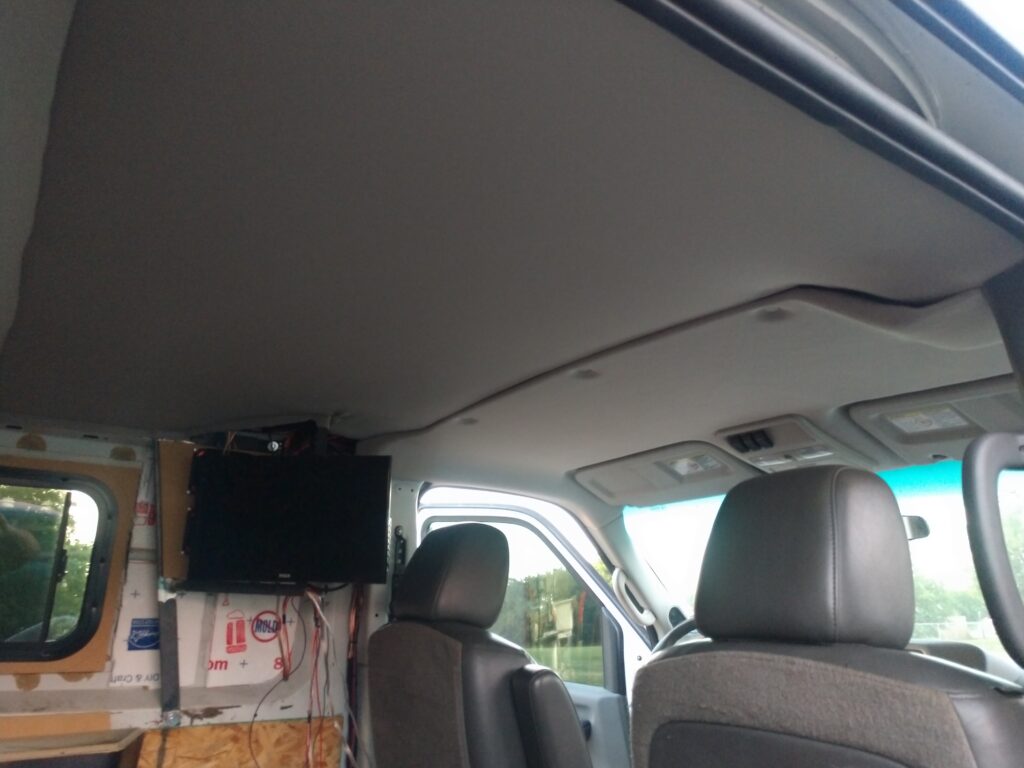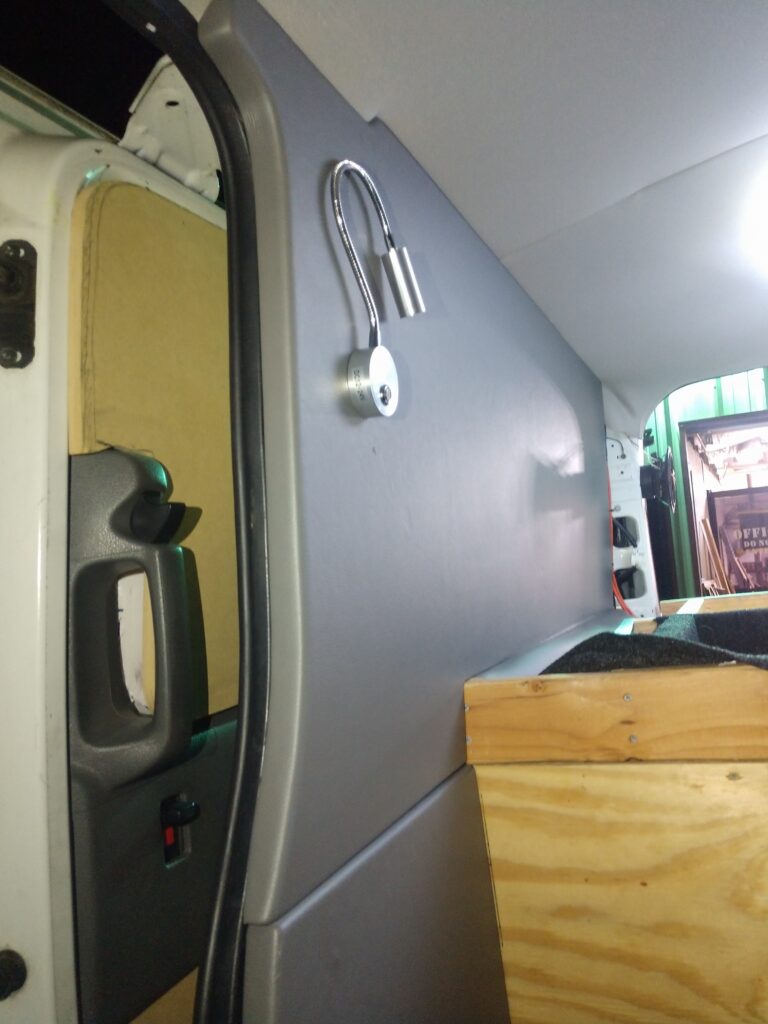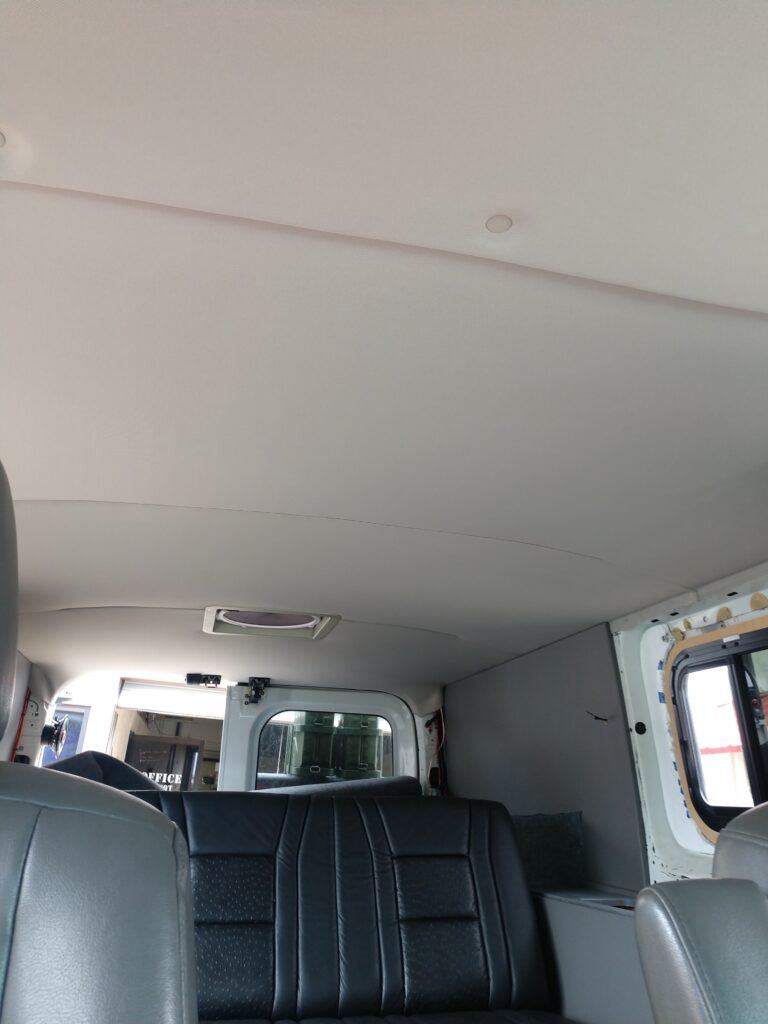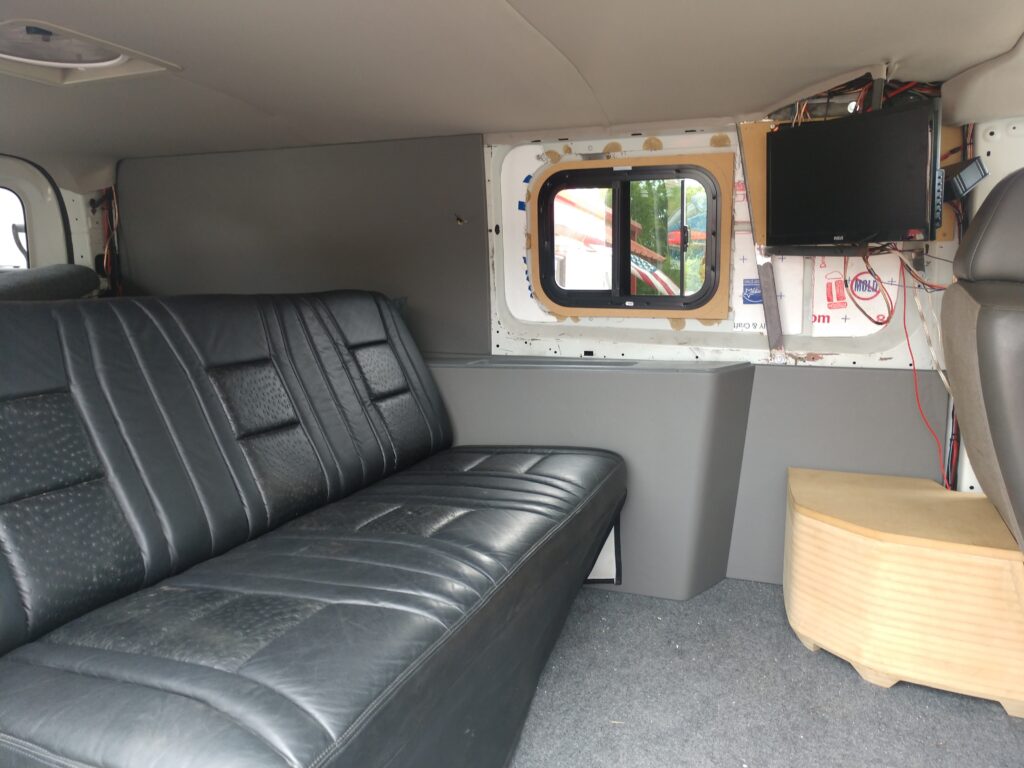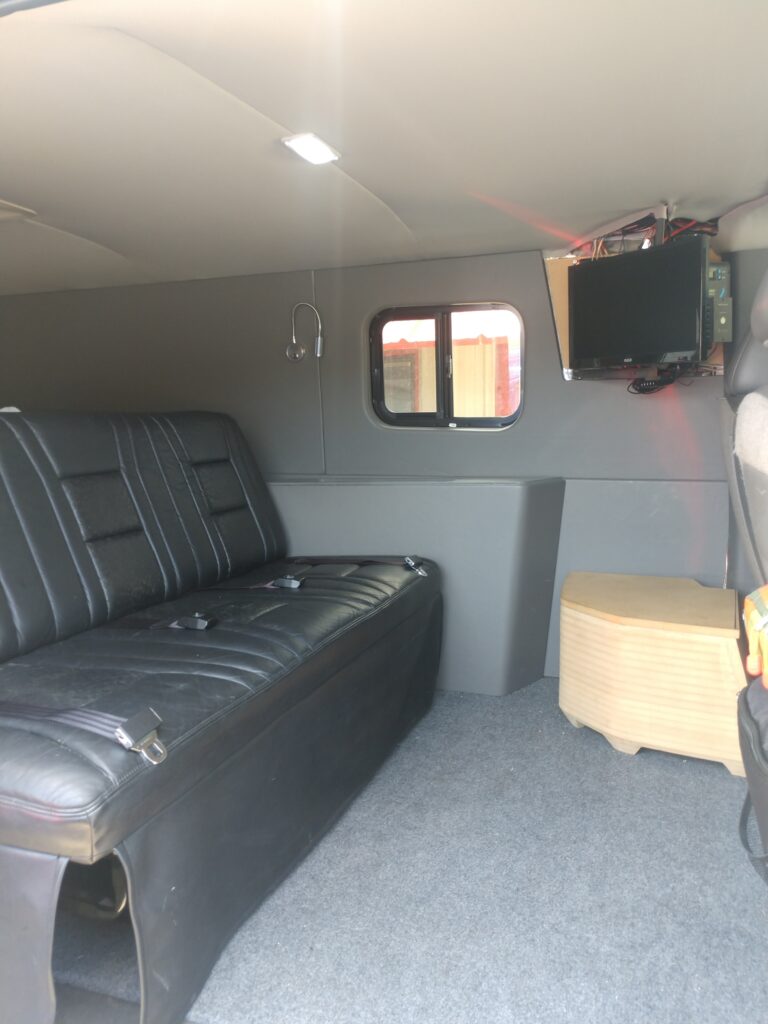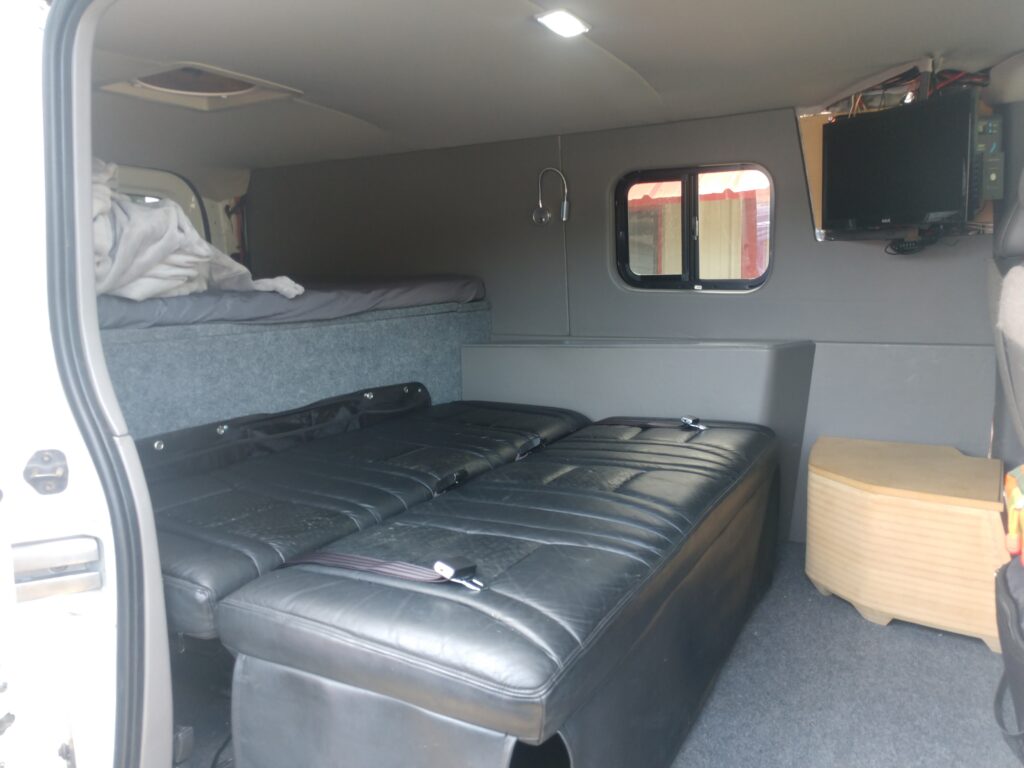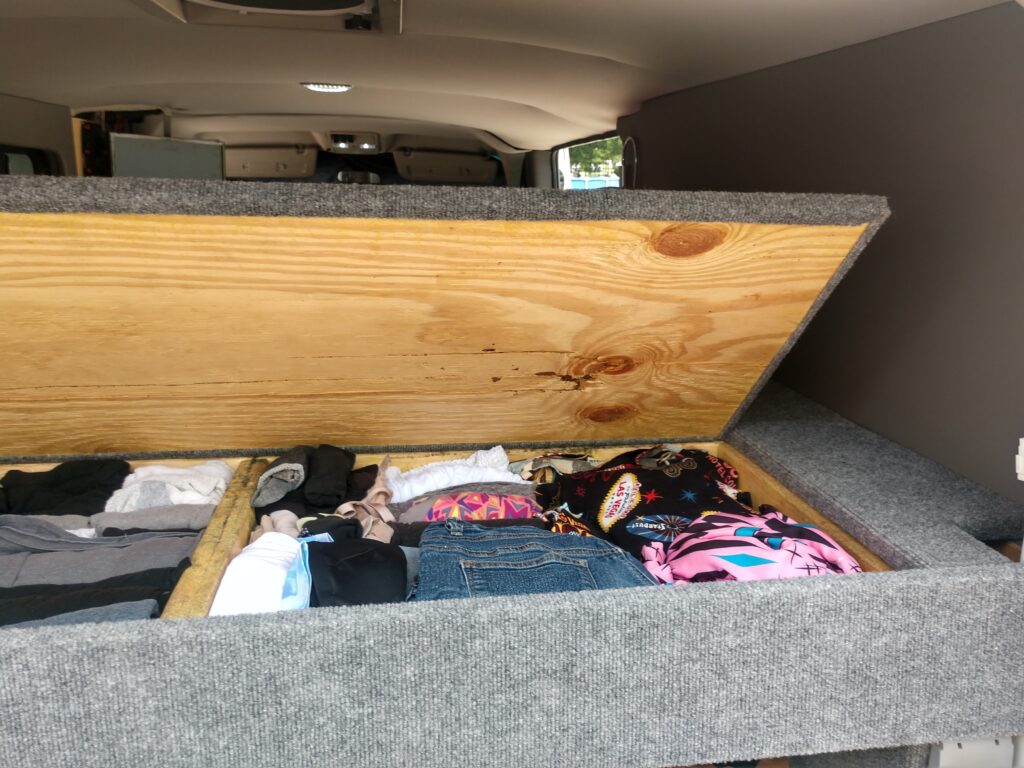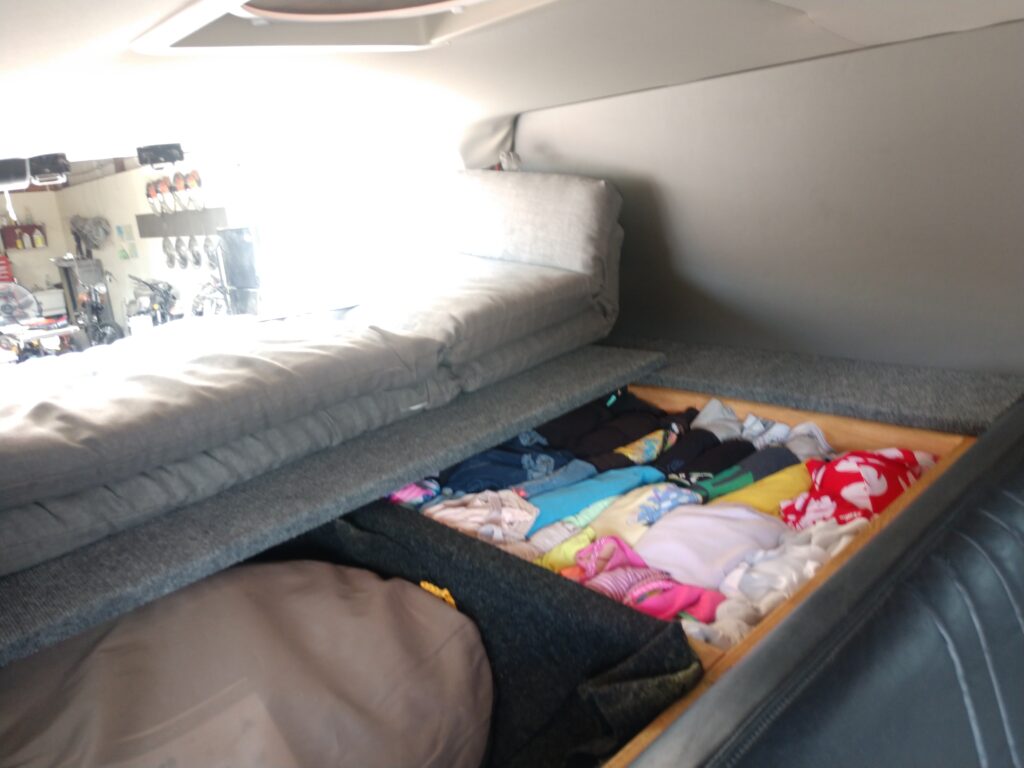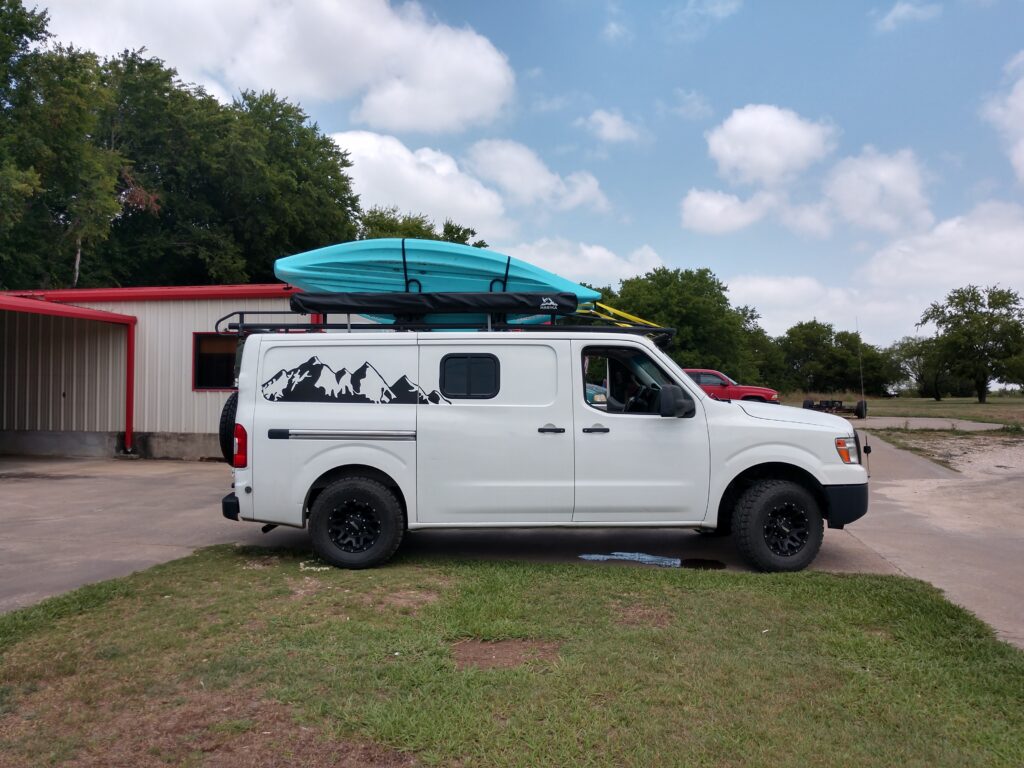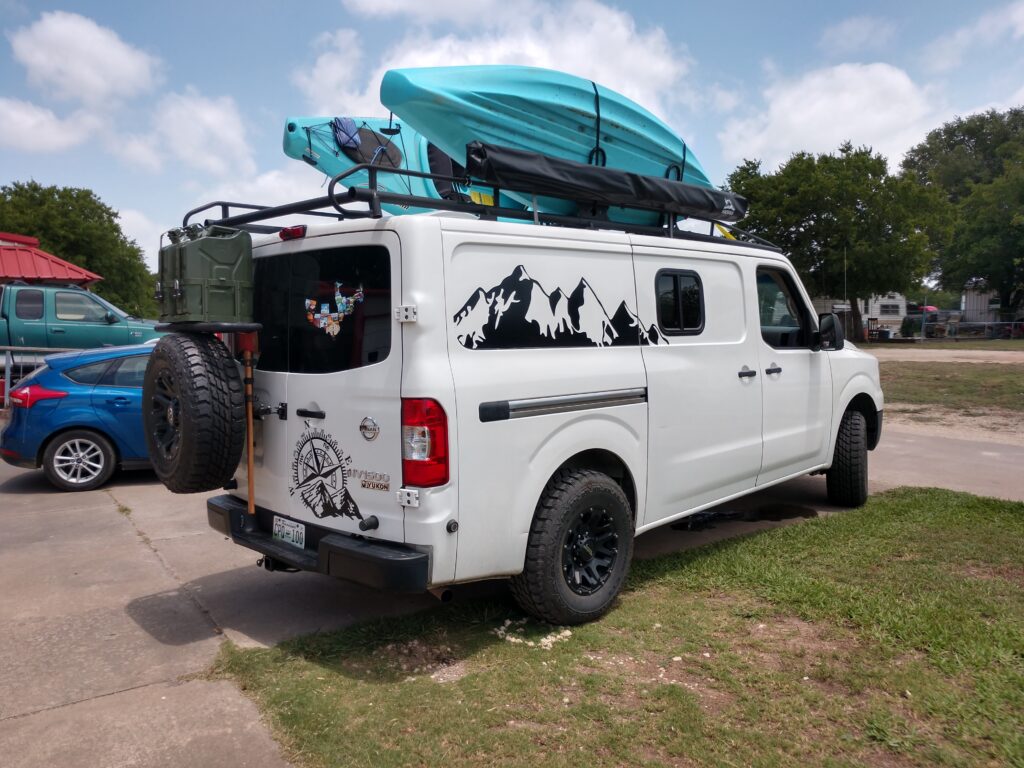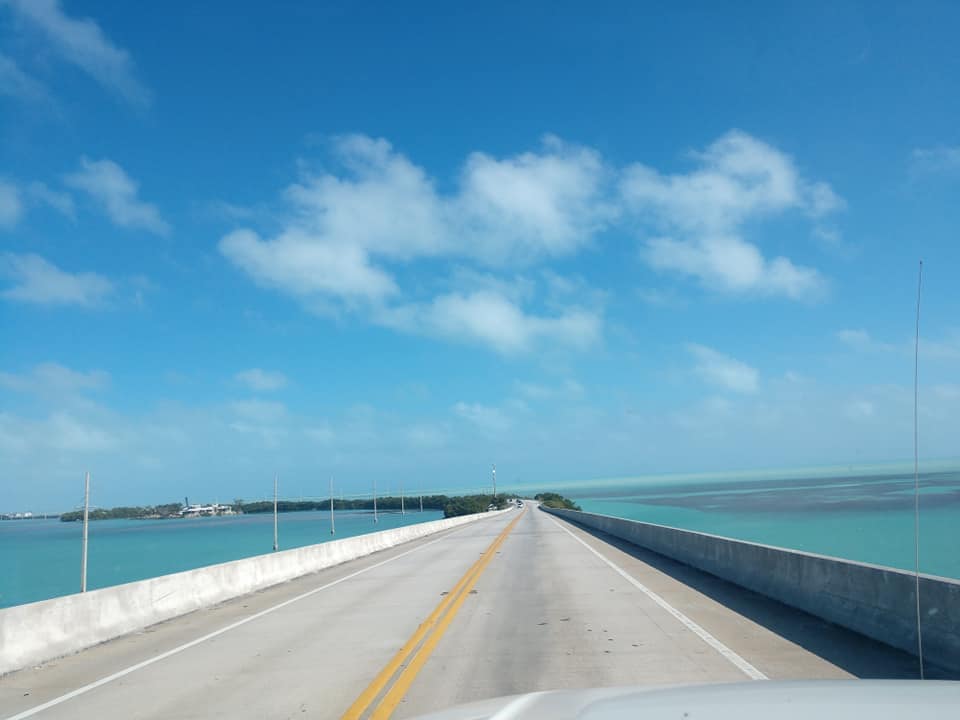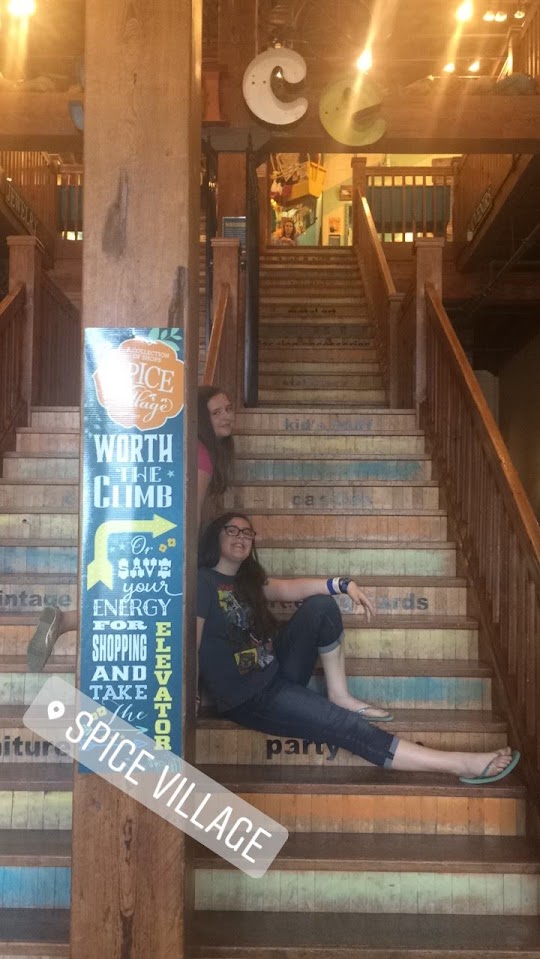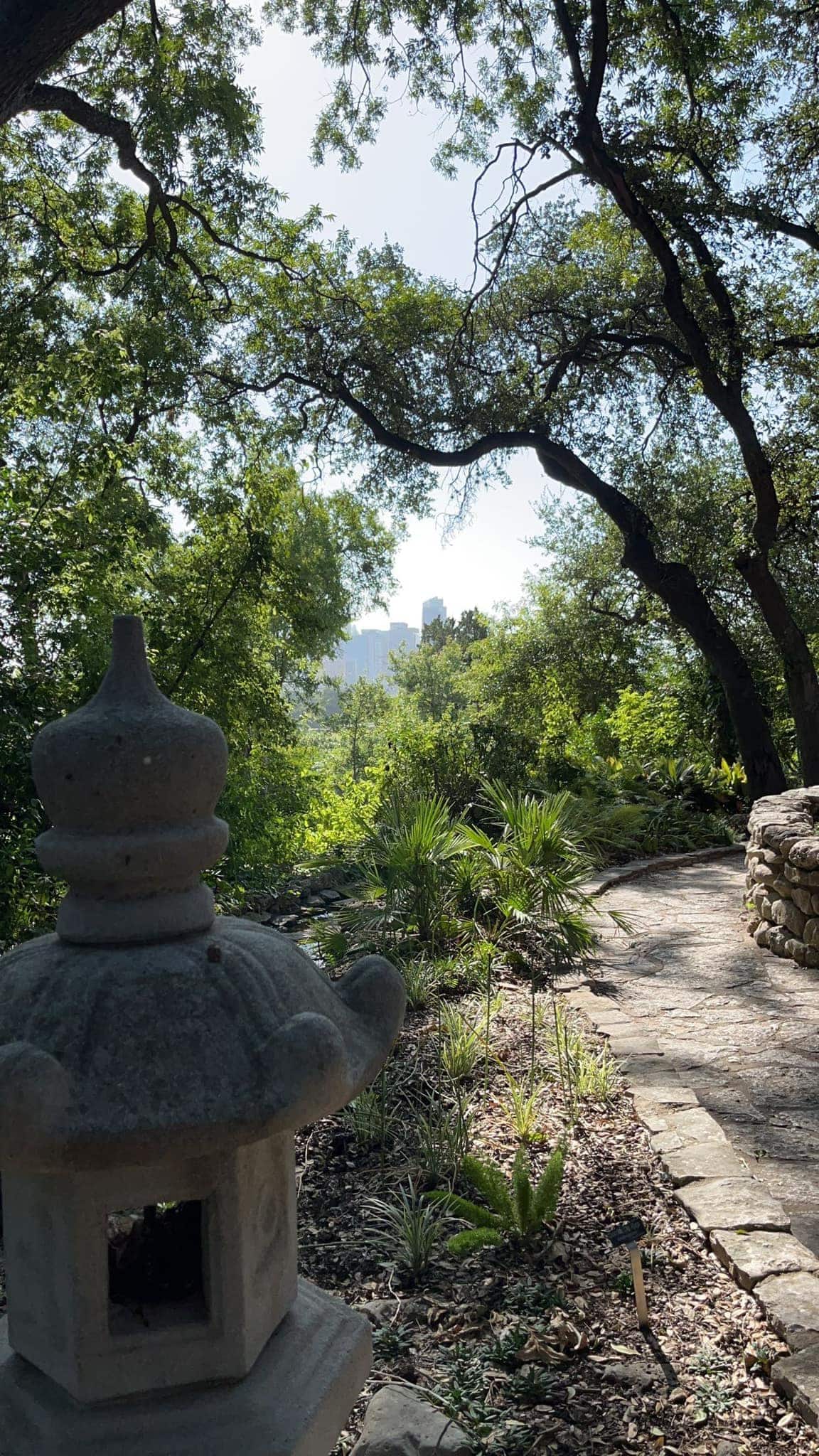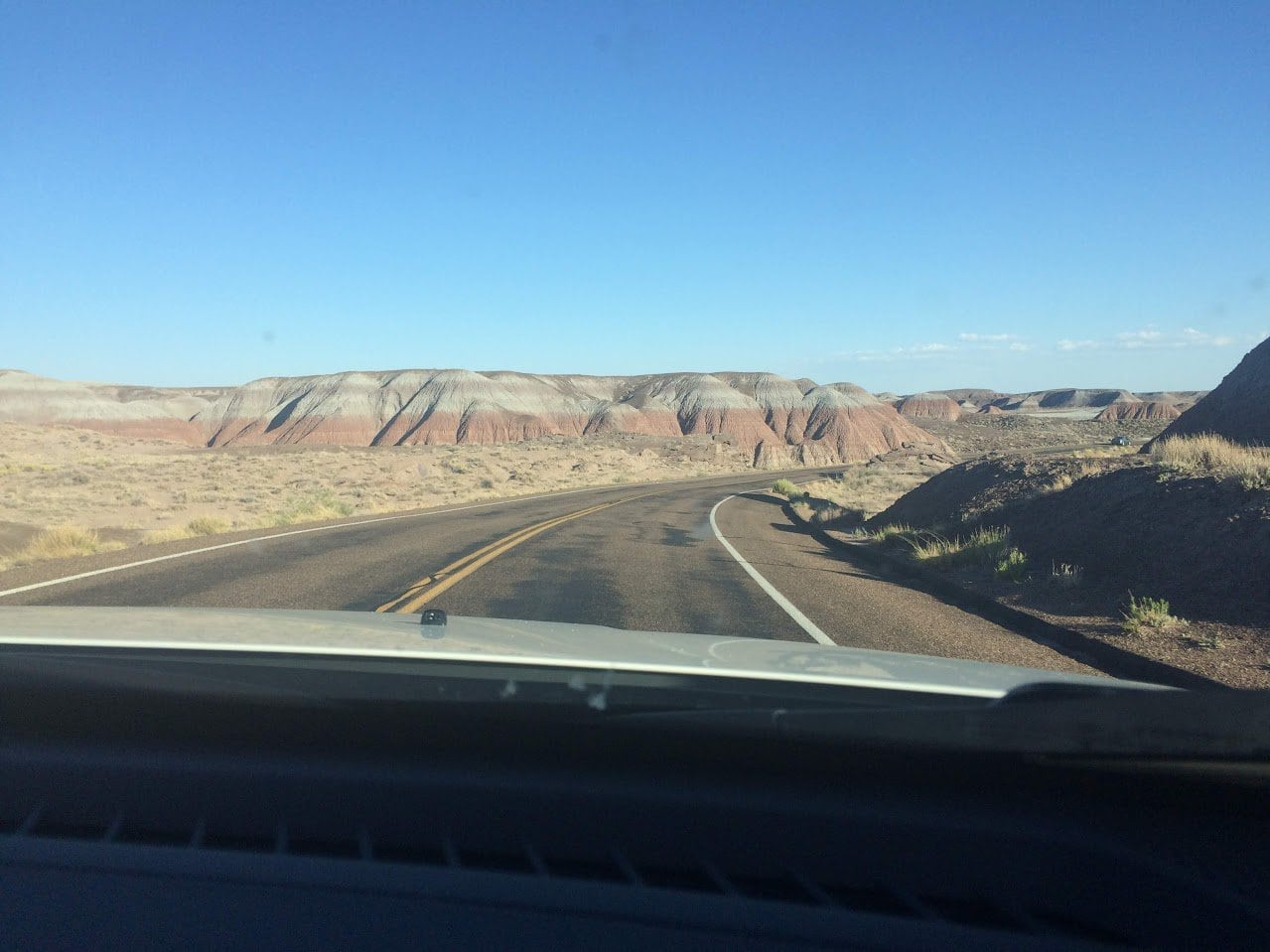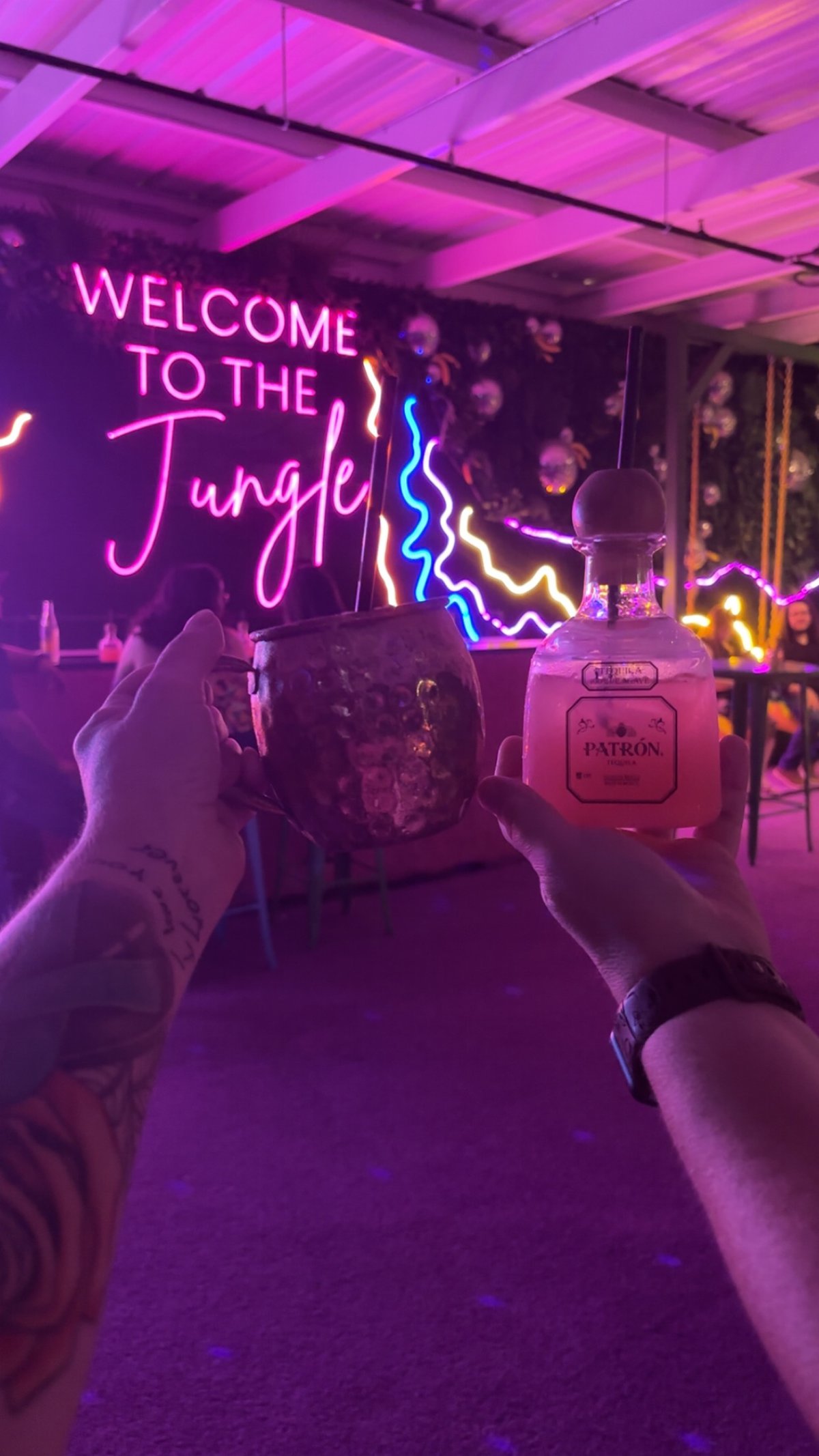Everything You Need to Know About Building a Camper Van
Note: Brandon Taylor wrote this post about building our van in August 2020. His wife edited it to fit Kale & Campfire’s style. We hope you enjoy it!
In the Beginning: Nissian NV1500
Our travel van came into existence by pure coincidence and chance. Here’s a condensed, oversimplified version of the story so far.
The company I work for decided to retire it and offered to sell it. After some discussion, we settled on a number I couldn’t turn down. It was sent to our maintenance shop for an oil change before I took delivery.
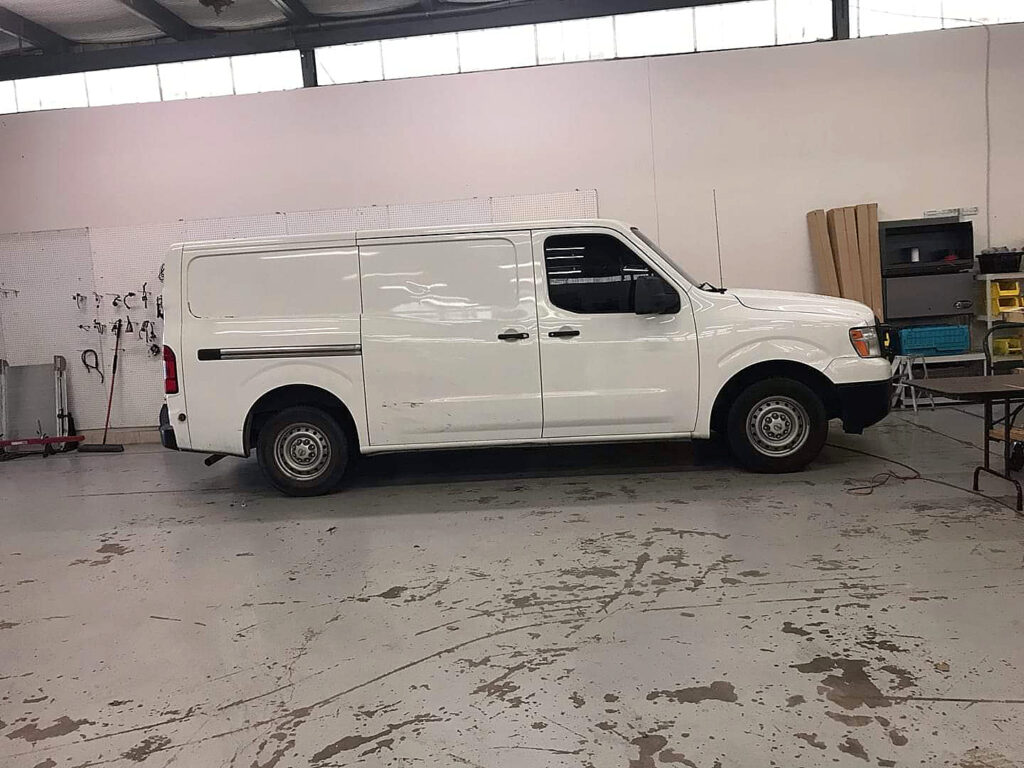
Of course, I am referring to the 2012 Nissan NV1500 van. At the time of purchase, it had 175xxx miles, and the motor had been replaced about 50xxx miles prior. This particular van was originally used in our Dallas market before being transferred to Houston for a few years. Upon arriving in Dallas, it was placed in service as the company’s mobile wheel and tire van. We sometimes handle wheel/tire theft jobs where the vehicle has been dropped on logs, blocks, bricks, or directly on the ground. This was the rescue vehicle, so to speak.
We stopped handling these types of jobs for a while due to a shift to other types of work and also began to trend towards smaller service vans. At that time, the decision was made to retire this beast from service rather than reassign it to a mobile technician.
Information About the NV1500 Van
For those that don’t aren’t familiar with the Nissan NV line, the NV is offered in a few different configurations. Both high and low roof options are available for the 2500 and 3500. The 3500 is also available as a passenger model with rear A/C and a full interior with multiple rows of seats. The 3500 is offered only with the V8, while the 2500 is offered with the choice of V8 or V6. Being the 1500, this van is only available in one configuration: Low roof, Cargo, V6.
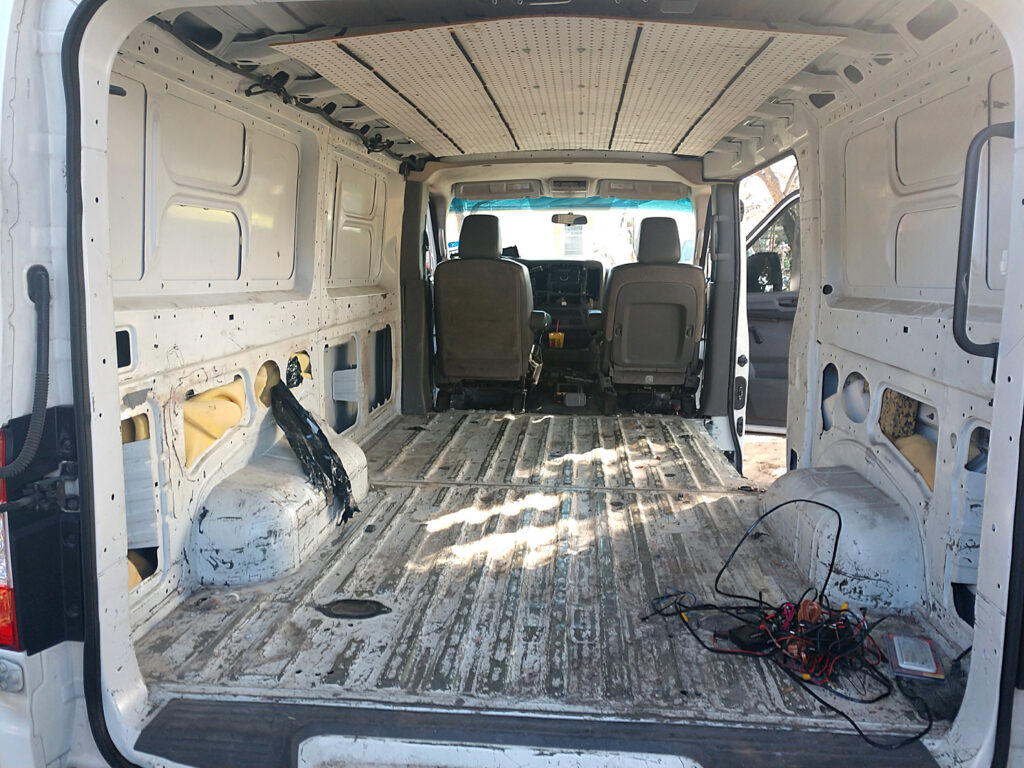
The original plan
was to keep this cheap vehicle around for running parts and materials and completed jobs so that I would be able to part ways with my, at the time, 20-year-old F150 that was nearing 300,000 miles. So we started to outfit the van on the cheap. I assembled a kit of backup sensors and rearview camera from leftover parts that I kept on prior jobs, purchased the cheapest name-brand double-din DVD screen I could find with Bluetooth, and put in some leftover bucket seats from a hotrod project I bought a few years ago.
The van stayed in this configuration for about 6 months before a few changes were made. The radio soon got a pair of 10″ subwoofers and an amp that came out of a totaled vehicle headed for the salvage yard, and the decision was made to insulate the floor and roof to quiet things down. The thin underlayment was added to the floor before 1/2 plywood was added, and the carpet was finally finished with leftover carpet from the work’s SEMA display the year prior.
Did I mention this was all being done as cheaply as possible? Sound deadeners were installed on the roof and side panels—yep, you guessed it: leftovers from another job. 1-inch foil-backed foam insulation sheets were cut down and bonded to the roof and side walls. The sides also have a layer of carpet jute. Keeping with the theme, the jute pad was salvaged from leftovers and is still in the van today.

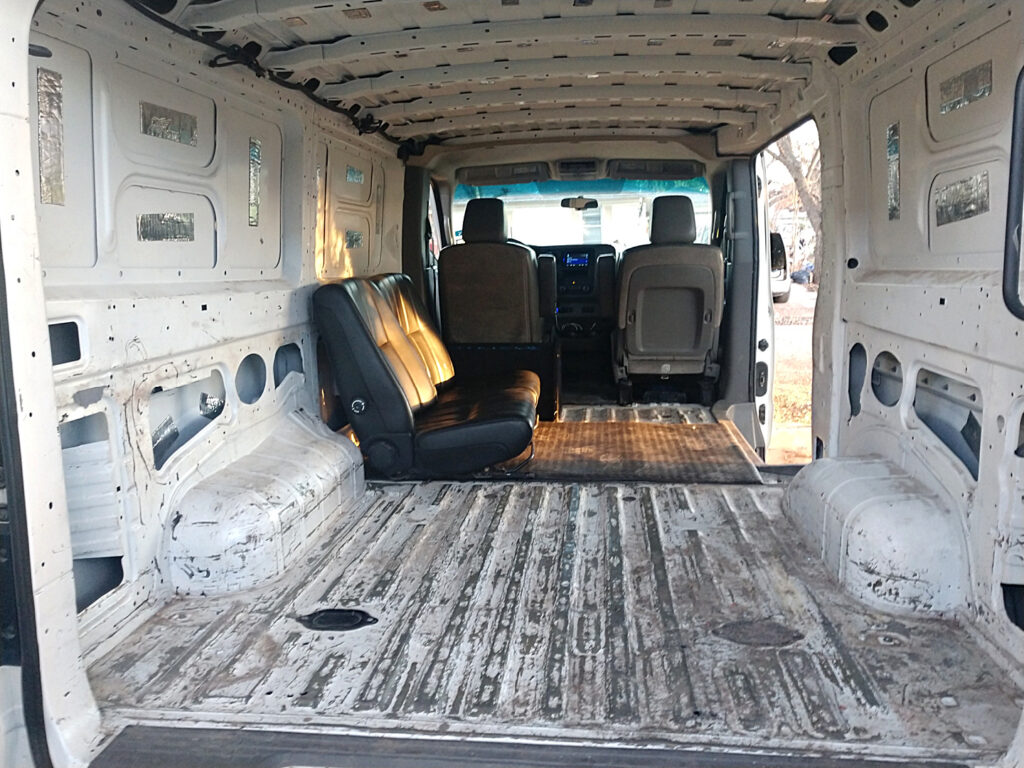
In February 2019
Another full-size van was reviewed to determine whether it needed to retire or would go back on the road. It was another NV1500 with only 135xxx miles, but it had quite a bit of damage around the rear bumper and on the quarter panels. Before retiring it, we attempted to bring it back up to serviceable condition. Besides a headlight and bumpers, none of the body damage was dealt with.
The van also received new brakes all around and a steering gearbox to eliminate the wondering that it had driving down the highway. After all that work, the new steering gear had faulty internal valves that the supplier would not warranty. Rather than buy another new box for $800, this van was retired in April. This van was offered to me for sale, but for nearly 4 times what I paid for the other. I declined, and it was scheduled to go to auction.
Before going to auction, I could swap out any parts I wanted for mine. Since my van had some damage around the side door handle from an attempted break-in in Houston and the fender was dented, I swapped these parts out. Of course, I couldn’t pass up the brand-new bumpers either. The sliding door was pretty interesting, considering I was on crutches with a broken ankle then.
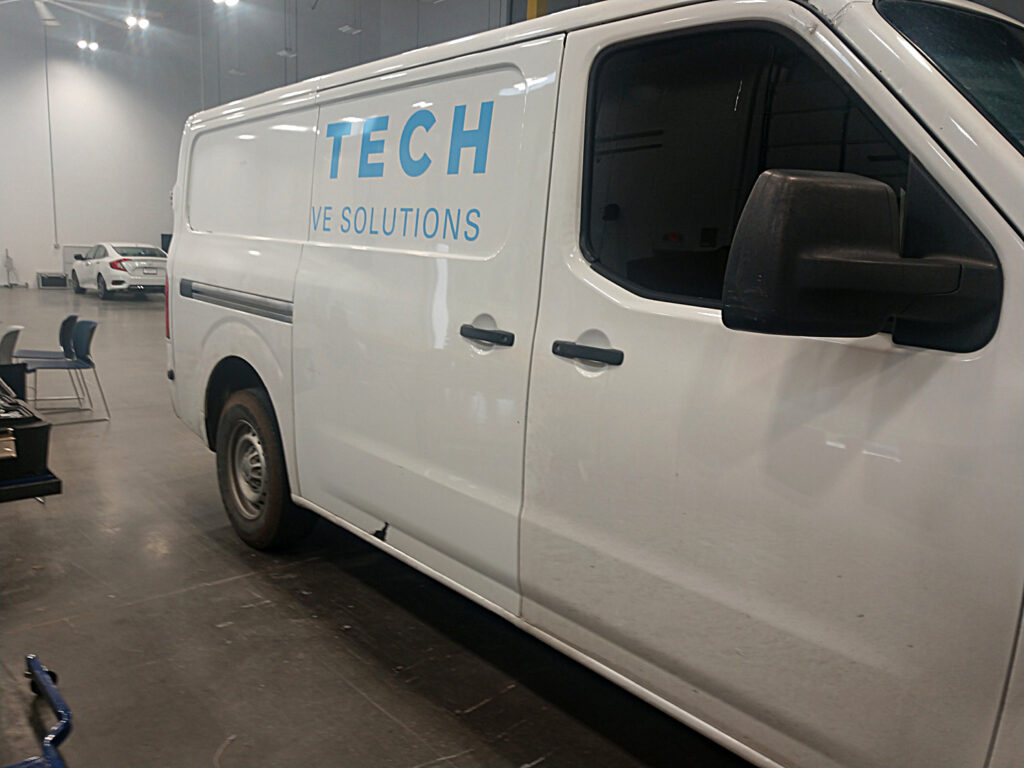
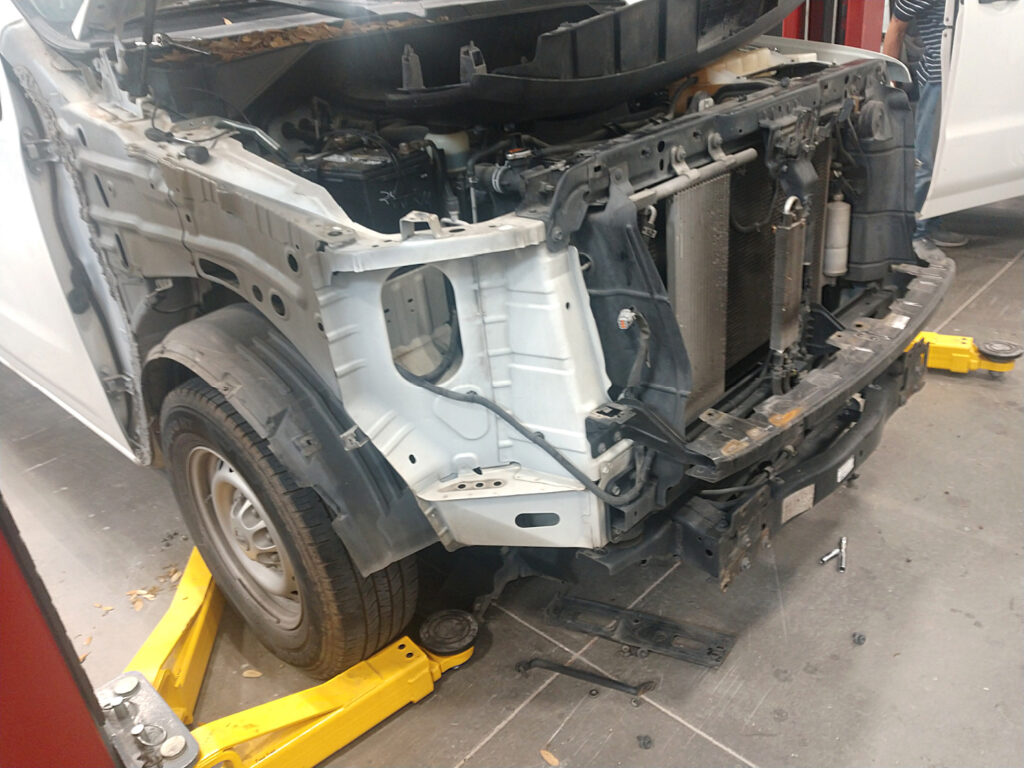
September 2019
At this point, I think the total investment in the van (after purchase price) was about $250-300 and maybe 10 hours of labor. We continued to use the van this way for a while, taking it grocery shopping, hauling side projects back and forth, and even taking a road trip to the Gulf Coast for a few days. This is where my life starts to get a bit complicated…
So, Houston – road trip – complicated… Still following along?
We set a course for Houston with beach and fishing gear in the back and the kids in the sketchy bucket seats. Galveston, Kemah, the whole 9 yards. We looked into renting jet skis, at $100 each for an hour this would have been a good time but a terrible investment. Instead, we decided to pick up a couple of kayaks and get on the water that way. For the short trip from where we bought the kayaks to the bay where we put them in the water, the kids were a little cramped but managed since the boats took up a ton of interior space. This would not work for the return trip, considering it would be about 4 1/2 hours home.
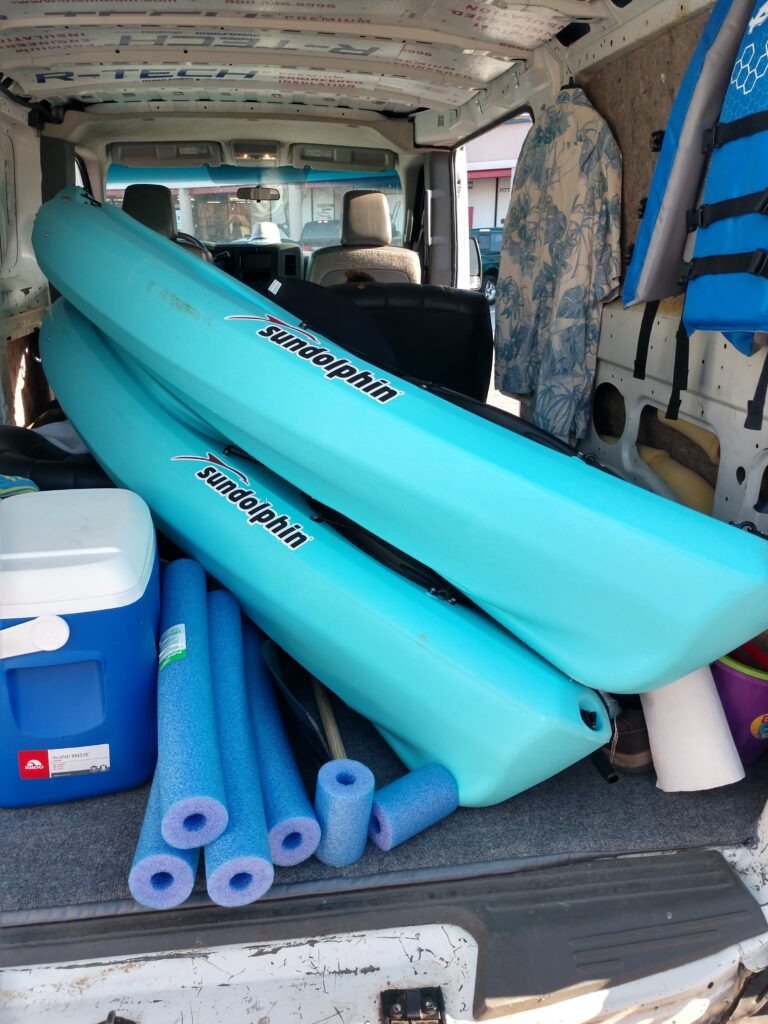
Lightbulb!
Using my engineering skills, we set a course for Harbor Freight. Zip ties, ratchet straps, and a few other pieces of hardware… Somebody run next door and get me a couple of pool noodles. Now we’ve got it.
Using the straps and D rings, I constructed a cradle system that held the kayaks off the roof, separated from each other, and securely in place the entire drive home. The pool noodles helped to keep the hardware from rattling against the kayaks and prevent damage to the paint. This system worked very well, and we quickly reclaimed all of our interior space.
BUT… (There’s always a but, isn’t there?) It was a bit of a pain to construct and secure this strange contraption to the roof every time you wanted to get out on the water. Back to the drawing board, or in this case, Craigslist. Roof racks? Too expensive. This is supposed to be cheap, remember?
Hmmmm, how about a ladder rack? Sure enough, $100 later and a bit of interesting loading and strapping skills later, we’ve got ourselves a ladder rack—strapped to the roof, upside down, sticking out front and rear.
After some quick cutting, grinding, and welding… the rack bolted on perfectly. The kayaks fit. Hell, we can even install a light bar to help see on the backroads at night.
If you’ve been paying attention, you realize that this is when things go from slightly complicated to a downward spiral.
The Look: New Tires
We’ve now got this awesome road trip machine; we can haul our crap a little easier. This thing really could turn into something. But it looks dull; that won’t work for me.
Chances are you’ve never tried to cram the largest tires you can under a cargo van with a sliding door. I can now say that I have. 34 x 11.50. That’s it; she won’t take any more without cutting or modifying the door. Even finding wheels at this point becomes complicated.
A half-ton rated cargo van with 8-lug heavy diesel truck wheels? Sure, I’ll go with that. Let’s remember that most trucks don’t have to worry about that pesky sliding door, though. Finding the right offset becomes a bit of an issue unless you are willing to buy some random wheels that fit but don’t really “FIT.” I quickly realized that used wheels were not going to happen unless I wanted to do away with the side door – not gonna happen.
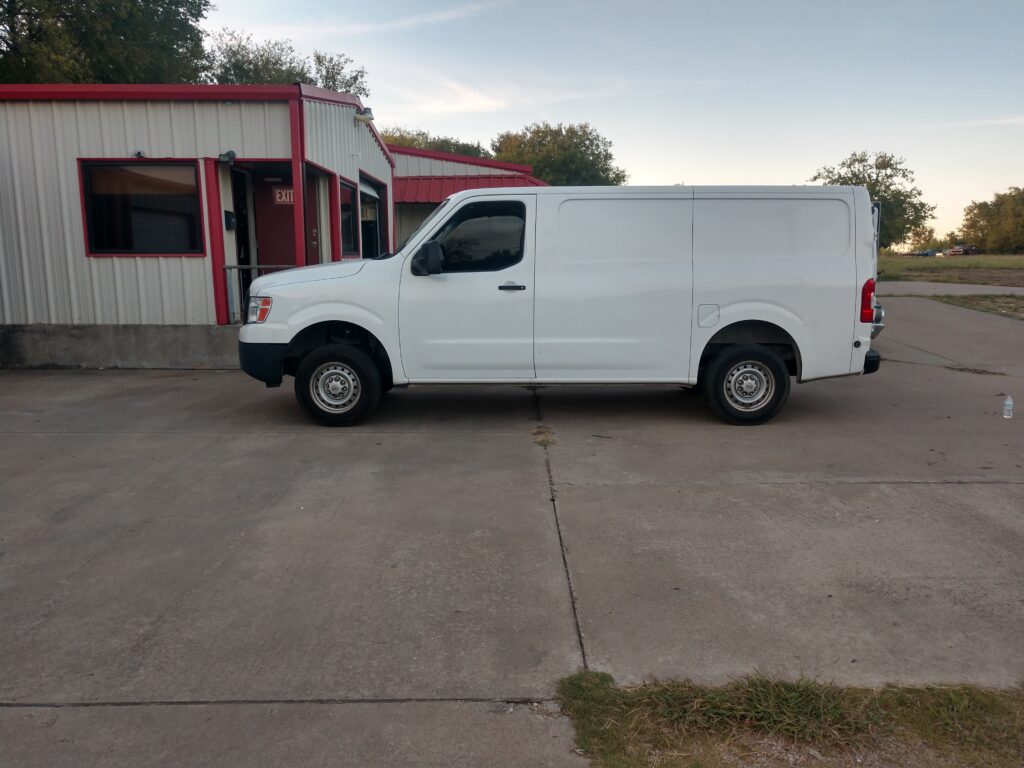
I finally settled on an American Racing Yukon AR200s set in 17×9 with a +18 offset. For most reading this, this information is ABSOLUTELY USELESS… but these measurements are gold for any fellow NV owners. Paired with El Dorado Wild Trail CTX tires in 295/70/17 and a 3/2 lift from Supreme Suspension. When installed, this actually lifted the front end almost 4 inches. We will revisit the suspension later since I know some things now that I didn’t then. But look at this. Completely transformed the look.

Seating in the Van
The look is starting to come together at this point, but the interior still leaves a bit to be desired. The bucket seats will not cut it, and there is no way to organize things. The radio sounds terrible in the back, and there is nothing to look at. Poor kids.
The van is obviously going to need to be comfortable if it’s going to be the new road warrior. Back to the marketplace, a few searches turned up a bunch of crusty velour conversion van seats – not the aesthetic (or smell) we are going for here. Most of them were either too big when folded down or too wide.
I found this wonderful (See: Sarcasm) faux ostrich-covered power folding seat. It will be recovered eventually, but it isn’t so atrocious that it can’t be used as it is for now. Cost – $100. And it works. And it’s decently comfortable.

Stereo System & TV
Now that the seat is handled, what about the rest? There’s more to an interior than just adding flooring and a seat, right? Throw a bit of wood, glue, and fabrication skills into the mix, and it starts to take shape quickly.
Adding a TV for the rear seats means the current in-dash unit will not cut it. And because the car is never the type to do just what’s needed, this led to a complete revamp of the audio/video system.
Alpine Type R 12 in a custom box, 2 Rockford amps, speakers from Cadence (3-way components up front and coaxials in the rear), and an Android Auto-capable dash unit.
The Van Rack
Things really start to snowball from here. The van that was once planned to be a quick, cheap build now has plans to be finished out nicely.
- The water system that was never originally planned for? Yep, add that to the list.
- Additional batteries and charger: Of course.
- Solar panels: Well, they might as well at this point.
- Matching spare: I have to have it, but where?
- Spare tire carrier: I don’t have much choice now.
- Windows: The kids might want to see outside.
The spare tire carrier was the first item checked off this list. Off-the-shelf options for the Nissan NV are very limited. All that comes to mind is a rear bumper replacement with a swing-out carrier, but it blocks the rear door from going past 90 degrees.
With the plans for the awning, kitchen, and outdoor shower, we couldn’t lose that much motion on the rear doors. I scoured the internet for a few weeks, looking at the offerings in the Sprinter and Transit world before finding a design I thought could be adapted to the NV.
I picked up some tube steel and hinges and let the sparks fly.
This design proved a win, even allowing for the addition of a rack to store 10 gallons of fuel and some basic tools. Building this took a full week of nights after work to get dialed in and the following weekend to get painted and installed.
Tires for the Van
Enter COVID, and the county shut down. Between installing the wheels and tires on the van and deciding to order a matching spare, the manufacturer discontinued the wheels I used. While ordering the spare, the rep at Discount Tire informed me there were only two left in the US… both sitting in a warehouse in LA.
It took about 5 weeks for the wheel to come in. The night the wheel arrived, I went old school and installed the tire on the ground using 2 pry bars and some starting fluid. The rack was finally done.
Water and Electrical
While we waited for the wheel to come in, all the solar parts arrived, including the parts for the kitchen, water system, side windows, and roof vent.
Knowing the interior would limit access to the areas needed to run wiring, the water and electrical were next on the list. We started by cutting holes in the side of the van for the water fill, sprayer outlet, and shore power connection.
With the spare tire out of the way, the water system could be assembled and installed. A 15-gallon water tank, shurflow pump, and accumulator all needed to be made to fit the space available. This was a fairly simple project involving some angle iron and aluminum plates. Routing the hoses into the side of the van was not quite as easy.
Now that the water system was completed, the focus shifted quickly to the needed electrical components. A custom bracket was fabricated to hold 2 deep-cycle marine batteries stacked vertically in one of the side compartments.
A 2000-watt inverter and 55-amp charger/power supply found their way into the compartment originally planned for battery storage. This compartment turned out to be too small for the batteries when the decision was made to change to 200 Ah of power storage rather than the original 90.
The additional space next to the charger and inverter provided the perfect storage location for extension cords, power adapters, and all the related electrical stuff one would carry on the road.
The solar system was next on the block, and the shore power and battery bank were completed.
Two 150-watt panels measured out perfectly to go side-by-side in the forward opening of the roof rack. The Renogy Adventurer 30 amp charge controller with a temp probe and battery sensor keeps the batteries topped off during sunny hours. A PAC-200 battery isolator relay was also installed to charge the batteries when the van was running.
Kitchen Area
Now we have power for the creature comforts and water to wash ourselves and dishes. Wait, dishes??? Oh, that’s right. We will need to eat at some point. Campfires are fine if you have the time and aren’t in a restricted area, but what if you don’t always feel like wrestling with getting a fire started? Constantly topping off coolers with ice gets old, as does the soggy food you get when the ice melts. Those problems don’t apply when you have a fridge and a stove.
Absorption fridges (see also: electric coolers) consume a lot of power and don’t offer much in the way of cooling. The world of 12v compressor-driven refrigeration has come a long way. There are options out there for most budgets. Dometic makes some very nice units at a cost. Less expensive players, such as companies like Costway, have come into the marketplace.
I was only willing to give up a certain amount of space for this item, which wasn’t enough for a Dometic or Costway. I did find a no-name company on Amazon selling a 50-quart bottle that fit my measurements, and it wasn’t hard on the budget either. A Coleman camp stove was the obvious choice for quick, reliable heat to cook on, and it was just big enough for our Lodge cast iron griddle.

The kitchen needed to be able to occupy minimal space while offering maximum space to prepare and cook food. I took some measurements and spent a little time on the computer designing how I thought the kitchen would be the most efficient.
Building our own kitchen design
Note to anybody wanting to build a similar setup – 48″ full extension drawer slides are not cheap. Only a few players offer any size with a decent weight rating, and they are very proud of them. If you can shrink your kitchen to less than 40 inches, things become much more affordable. One easy way to do this on a Nissan NV would be to go ahead and get a fridge from Costway or Dometic and put it between the front seats.
After the kitchen was built and painted, it was slid into place in the van. The desire to put it on the right side was quickly met with opposition from the door jamb. Interfering with the stove slide-out would have made things difficult, and we would have had to open both doors whenever we needed something out of the cargo area. When we moved to the left side, these problems were no longer an issue.
Nice Additional Kitchen Gear to Have
We found ample storage in the kitchen for all of our dishes. This is in part due to the Stanley cookware. The pots nest inside each other. Bowls nest inside the pots. Utensils nest inside the bowls. We even found out that the Rocket coffee maker nests perfectly inside the 2-cup cook set if you remove one cup. This compact, durable coffee-making solution was a requirement by one of the female components of the family. She knows who she is.
A collapsible dish drainer and wash basin also help keep space available for other things. We even lucked out and found a small folding table that fits perfectly into the cargo area, folding to 24x48x2 when collapsed and as small as 24x25x4 when completely folded.
Installing the Van Fan
Ever seen Swiss cheese? That’s what the van looked like for the next stages. Installing the MaxxFan required cutting a nearly 14″x 14″ hole in the roof. Since my helper was terrified of cutting the roof, she got to make the first cut. The fan went in with no drama. Some butyl tape and caulk sealed things up nicely. But air can’t flow well with just one hole.
CR Laurence makes some nice side windows for the NV, but I couldn’t justify it at over $600 per side (at the time of the build). I also didn’t want that much glass for mutliple reasons. Glass is obviously the weak point when worrying about theft and vandalism, conducts temperature outside (hot or cold), and reduces privacy. 15×20 sliding RV windows were the largest we’d be able to fit without interfering with the TV mount and came with screens preinstalled.
The complex shape of these windows and the tolerance of how tight the fit needed to be necessitated making a router template to help with measurements and installation. This template came in handy for making the inner spacers and interior panels.
The large white side of the van looked a little strange with the proportionately small windows installed. We will have to do something about that later.

It’s All in the Details
As with all projects, the devil is in the details. This one was no different. The final weeks leading up to vacation were a mad dash to finish everything… then to finish everything we could…, and then to just finish the stuff we had time for.
There were dozens of little things that needed to be done, each one taking slightly longer than expected. Rear seat belts, headliner, interior panels, rear interior lighting, cargo area lighting, heavier rear suspension, and lower gearing, all the small gauge wiring for the additional electrical… You get the idea.
All these little details add up to make for some late hours and short tempers. We missed the mark on getting everything finished before we left. The last 2 nights before departure were 4 am bedtimes, ensuring everything that wasn’t finished was safe, secure, and workable.
The morning we were supposed to leave was spent finalizing some temporary mounts for components that needed to be there but didn’t have a home yet and loading. 8 a.m. came and went, as did noon… but we finally got on the road at about 1:30.
Throughout this process, we all experienced victory, defeat, success, failure, success despite failure, and a general sense of accomplishment… all at the same time. Whenever something didn’t go as planned, it was a chance to try a better idea.
Want to See More from This Van Adventure?
Check out this post on Joshua Tree National Park or our information about Glacier National Park



